NASA's Voyager probes have been traveling through space for nearly 46 years. Here are 18 groundbreaking photos from their incredible mission.
- Nearly 46 years after their launch, Voyager 1 and 2 will likely soon reach the end of their scientific mission .
- NASA recently lost contact with Voyager 2 after sending it a bad command by mistake.
- Here are 18 pictures the probes took over the course of their forty-plus-year journey.

The Voyager probes are pioneers of science, making it farther into space than any other manufactured object. But now, they face a terminal problem: their power is running out.
The twin probes were originally sent on a four-year mission to tour the solar system, but they exceeded all expectations and are still going nearly 46 years later. That makes them NASA's longest-lived mission.
Scientists are now doing their best to keep the probes going for as long as possible. They recently found a clever hack to extend Voyager 2's life for another three years and plan to do the same with Voyager 1.
But these are old machines and NASA is constantly scrambling to fix mistakes. Last year, Voyager 1 started sending garbled data from the outside of the solar system. NASA ultimately figured out one of its computers had gone dead.
Voyager 2 is now in limbo , as the agency revealed Friday it had lost contact with the probe when someone sent a wrong command. It could be the end of Voyager 2's mission if NASA can't fix the mistake, which the agency probably won't be able to do before October.
As the probes are nearing the end of their scientific mission, here are 18 images from Voyager that changed science.

The Voyager probes were designed to visit Jupiter and Saturn.
The Voyager mission included two probes — Voyager 1 and Voyager 2 — which NASA launched in 1977 within a few months of each other.
NASA took advantage of a rare planet alignment to turbocharge their journeys into space.
NASA originally built the probes to last five years, but they have exceeded that lifespan many times .
As of August 20 and September 5, 2023, Voyager 2 and Voyager 1 will have been traveling for 46 years, respectively.
This is what Voyager 1 saw on its approach to Jupiter.
Voyager 1 and Voyager 2 reached Jupiter in 1979.
As they flew by the planet, they took about 50,000 pictures of Jupiter. These blew away scientists, as the quality of the pictures was much better than those taken from Earth, according to NASA.
These snaps taught scientists important facts about the planet's atmosphere, magnetic forces, and geology that would have been difficult to decipher otherwise.
The probes discovered two new moons orbiting Jupiter: Thebe and Metis.
They also spotted a thin ring around Jupiter.
The probe captured this picture as it was looking back at the planet backlit by the Sun.
Voyager 1 discovered volcanoes at the surface of Io, one of Jupiter's moons.
Next stop: Saturn.
In 1980 and 1981, the probes reached Saturn . The flyby gave scientists unprecedented insight into the planet's ring structure, atmosphere, and moons.
Voyager snapped Saturn's rings in more detail than ever before.
And showed every secret that Enceladus, Saturn's moon, had to offer.
Saturn, snapped as the probe flew away, was shown in a new light.
By 1986, Voyager 2 had made it to Uranus.
By 1986, Voyager 1 has finished its grand tour of the solar system, and few out towards space. But Voyager 2 kept on its exploring our nearest planets, passing 50,600 miles away from Uranus in January 1986.
Voyager 2 discovered two extra rings around Uranus , revealing the planet had at least 11, not 9.
Voyager 2 also spotted 11 previously unseen moons around Uranus.
Here is a picture of Miranda, Uranus's sixth-biggest moon.
Voyager 2 was the first spacecraft to observe Neptune from a close distance.
In 1989, 12 years after its launch, Voyager 2 passed within 3,000 miles of Neptune.
Here's Nepture taken by Voyager 2, in all its blue glory.
Voyager 2 took this unflattering pic of Triton's rough face.
It captured Triton, Neptune's moon in unprecedented detail.
And snapped Triton's southern hemisphere.
As it flew by, Voyager 2 uncovered Neptune's rings.
As its parting gift, Voyager 2 took this beautiful picture of light grazing Neptune's south pole.
This is Voyager 2's last picture. Since it wouldn't come across another planet on its ongoing journey, NASA switched off its cameras after its flyby of Neptune to conserve energy for other instruments.
Voyager 1 had one last trick up its sleeve.
As its last photographic hurrah in 1990, Voyager 1 took 60 images of the solar system from 4 billion miles away.
It gave us the Earth's longest selfie, dubbed the "pale blue dot."
This remains the longest-range selfie: a portrait of the Earth taken by a human-made probe from 4 billion miles away.
After this picture, NASA switched off Voyager 1's cameras to save energy. NASA could switch the probes' cameras back on , but it is not a priority for the mission.
Beyond the solar system
Though the probes are no longer sending pictures, they haven't stopped sending crucial information about space.
In 2012, Voyager 1 became the first human-made instrument to cross into interstellar space by crossing the boundary between our solar system and the rest of the universe, called the heliopause.
Voyager 2 was second, crossing that threshold in 2018 . The probe revealed that there was yet another layer outside of our heliosphere.
The probes keep sending back measurements from interstellar space, like weird hums likely coming from vibrations made by neighboring stars.
Even after their instruments are switched off, the probes' mission continues.
NASA is planning to switch more of the probes' instruments in the hope of extending their life to the 2030s.
But even after all their instruments become quiet, their mission will carry on. As they drift off, they will still be carrying a golden record that carries crucial information about humanity. If intelligent extraterrestrial life exists, they could use that information to reach out to us.
This article was originally published on June 6, 2022, and is being updated with the latest developments about Voyager 1 and 2.
- Main content
- The Inventory
Support Quartz
Fund next-gen business journalism with $10 a month
Free Newsletters
Let’s take a moment to look at the mesmerizing images from Voyager 1
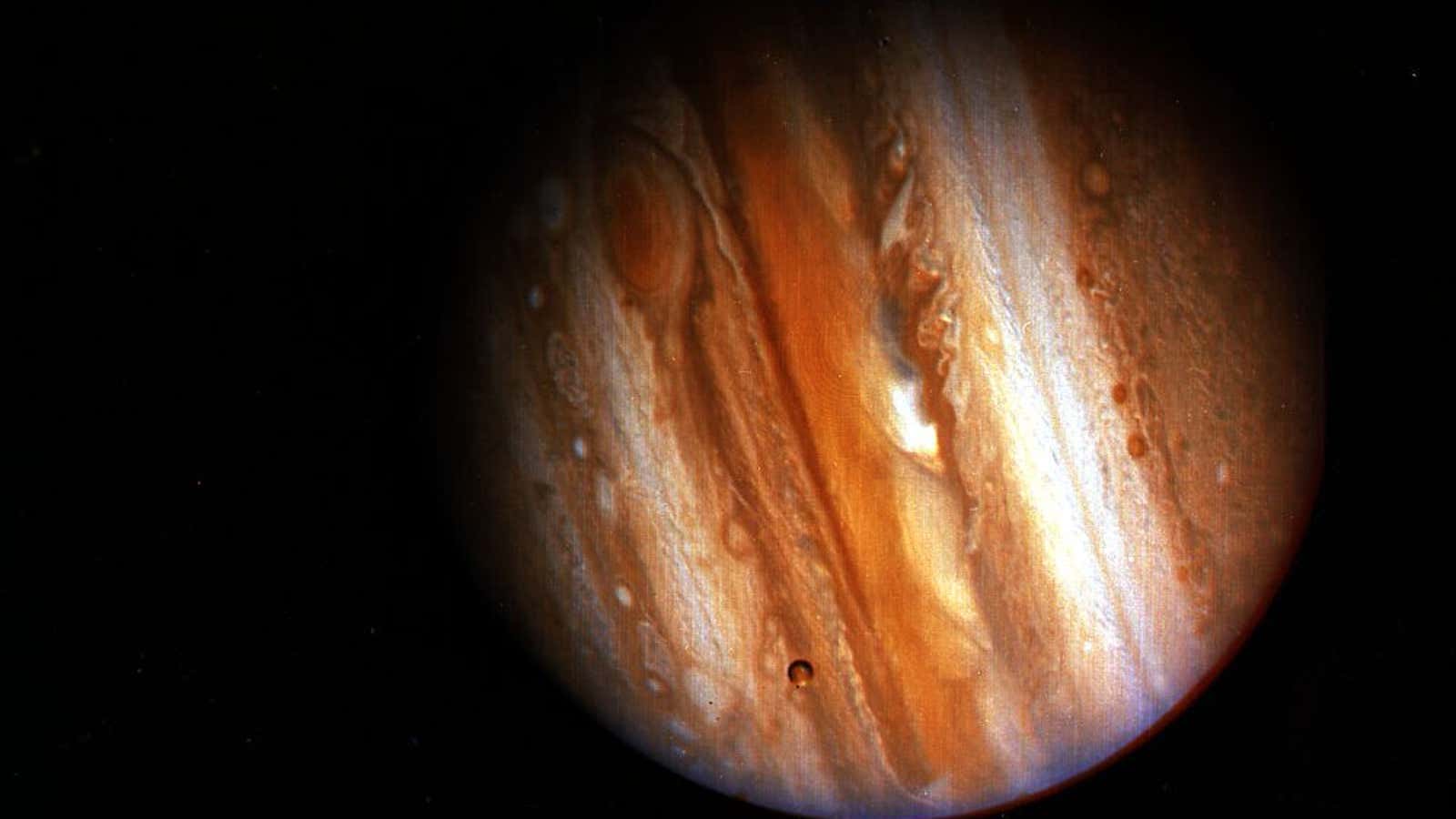
In 1977, NASA launched two Voyager probes, equipped with golden records describing human accomplishment, on a mission to explore the farthest reaches of the solar system. Each record catalogued our music, our greetings, our art and photography.
Forty years later, both spacecrafts are still hurtling through space , exploring parts of the universe where nothing from Earth has visited before. Voyager 1 is now in interstellar space, 13 billion miles away from Earth. Voyager 2 is passing through the heliosheath, the outermost layer of the heliosphere, before it, too, reaches interstellar space.
Last week, in an amazing feat of engineering, NASA engineers turned on Voyager 1’s backup thrusters after they’d been dormant for 37 years. The thrusters will help reorient the spacecraft’s antenna back to Earth, so we can receive its signal for just a little longer.
It’s a fine moment to reflect on the incredible images Voyager 1 has sent back over its lifetime. The probe gave us the first “ portrait ” of our solar system, and memorably mesmerizing shots of Saturn and Jupiter.
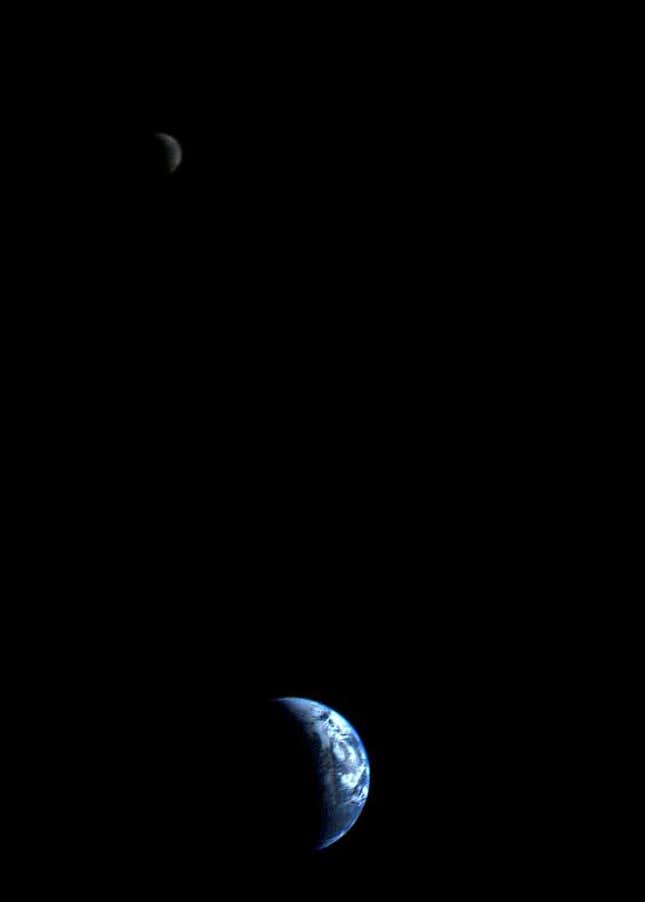
Watch NASA’s moving compilation of images from both Voyagers below:
📬 Sign up for the Daily Brief
Our free, fast, and fun briefing on the global economy, delivered every weekday morning.
- TECHNOLOGY BUSINESS ENTERPRISE COMMS START-UPS ALL
- SCIENCE INNOVATION MACHINES CLIMATE ALL
- CAREERS ADVICE PEOPLE EMPLOYERS JOBS NEWS ALL
- FUTURE HUMAN
- MORE VIDEO ADVERTISE FOLLOW US CONTACT ABOUT COOKIE & PRIVACY POLICY
Five images that shook the world as Voyager 1 hits 40
by Colm Gorey
An artist's concept depicts NASA's Voyager 1 spacecraft entering interstellar space. Image: NASA/JPL-Caltech
Now 40 years old and in interstellar space, NASA’s Voyager 1 spacecraft has already been immortalised in these incredible photos.
On 5 September 1977 – two weeks after Voyager 2 – Voyager 1 blasted off from Earth on its mission to photograph and study the outer planets of our solar system.
While hard to imagine now, our only images of these planets at that time were fuzzy and small, as our only way of observing them was through Earth-based telescopes.
The Voyager spacecraft presented an opportunity for scientists to actually see Jupiter, Saturn, Uranus and Neptune – and 48 of their moons – up close and personal for the first time.
As each planet was snapped, the amount of excitement that came with each returned photograph sent NASA’s scientists into raptures as, for the first time, a number of geological breakthroughs were recorded.
Among them were the first images of spewing volcanoes on another planet, the discovery of an Earth-like atmosphere on the Jovian moon of Titan and the first signs of a possible vast ocean beneath the dense, icy crust of Europa.
But, for many, the Voyager 1 spacecraft remains famous for its ‘golden record’: humankind’s message in a bottle to the universe that could (albeit in an unlikely circumstance) lead to an extraterrestrial species finding out about us.
Led by Carl Sagan, the golden record project attempted to cram as much information about our species as possible onto a single disc, including images, sounds and even a diagram explaining how to play the record to an alien species.
So, when news came through that Voyager 1 had broken out of the confines of our solar system in 2012, the realisation that the disc is now going to be travelling for potentially billions of years – long after our planet has been consumed by the sun – began to sink in.
All good things must come to an end
What makes the 40th anniversary perhaps more important than, say, its 50th, is that by that time, NASA estimates that the craft will be, for all intents and purposes, ‘dead’.
Beginning this year, NASA will shut down its instruments, starting with its gyroscopic operations, then its data tape recorder next year and its other instruments by 2020.
After that, the craft’s nuclear power source is expected to finally come to an end sometime between 2025 and 2030, silencing it forever as it continues on its incredible journey.
So, on its 40th birthday, here are just a few of the incredible images returned by the craft that not only changed our perspective on the universe, but our very understanding of it.
Voyager 1 photo taken at a distance of 5.3m km from Saturn. Image: NASA/JPL
Voyager 1 image of Io showing active plume of Loki on limb. Image: NASA/JPL/USGS
An image assembled from three black-and-white negatives taken by Voyager 1 of Jupiter’s giant red spot. Image: NASA’s Goddard Space Flight Center. Video and images courtesy of NASA/JPL
Layers of haze covering Saturn’s moon Titan are seen in this image taken by Voyager 1. Image: NASA/JPL
The famous ‘Pale Blue Dot’ image that provided a family portrait of our solar system, and a view of Earth (right centre) that put our lives into perspective. Image: NASA/JPL
Related: space exploration , space-tech , astronomy , NASA , Voyager
Colm Gorey was a senior journalist with Silicon Republic
You May Also Like
NASA’s Juno mission takes sizzling shots of Jupiter’s volcanic moon
James Webb spots a cocktail of compounds around two stars
14 Mar 2024
James Webb data suggests we have ‘misunderstood the universe’
21 Mar 2024
James Webb finds frenzy of activity in starburst galaxy
Third time unlucky: Starship explodes in ‘successful’ test launch
Stunning new images shed light on how planets form
More from science, latest news.
- Become A Member
- Gift Membership
- Kids Membership
- Other Ways to Give
- Explore Worlds
- Defend Earth
How We Work
- Education & Public Outreach
- Space Policy & Advocacy
- Science & Technology
- Global Collaboration
Our Results
Learn how our members and community are changing the worlds.
Our citizen-funded spacecraft successfully demonstrated solar sailing for CubeSats.
Space Topics
- Planets & Other Worlds
- Space Missions
- Space Policy
- Planetary Radio
- Space Images
The Planetary Report
The eclipse issue.
Science and splendor under the shadow.
Get Involved
Membership programs for explorers of all ages.
Get updates and weekly tools to learn, share, and advocate for space exploration.
Volunteer as a space advocate.
Support Our Mission
- Renew Membership
- Society Projects
The Planetary Fund
Accelerate progress in our three core enterprises — Explore Worlds, Find Life, and Defend Earth. You can support the entire fund, or designate a core enterprise of your choice.
- Strategic Framework
- News & Press
The Planetary Society
Know the cosmos and our place within it.
Our Mission
Empowering the world's citizens to advance space science and exploration.
- Explore Space
- Take Action
- Member Community
- Account Center
- “Exploration is in our nature.” - Carl Sagan
Bruce Murray Space Image Library
Highest resolution Voyager 1 color view of the Great Red Spot
The color in this mosaic was rather difficult to process. The WAC filters are significantly different from the corresponding NAC filters and the left/right edges are not covered by all three WAC filters. There are also some areas in the NAC mosaic where only green or violet was available (especially near the corners of the NAC area). The color is somewhat less accurate there.
For full functionality of this site it is necessary to enable JavaScript. Here are instructions on how to enable JavaScript in your web browser .

The Pale Blue Dot – Revisited

The Pale Blue Dot is a photograph of Earth taken Feb. 14, 1990, by NASA’s Voyager 1 at a distance of 3.7 billion miles (6 billion kilometers) from the Sun. The image inspired the title of scientist Carl Sagan's book, "Pale Blue Dot: A Vision of the Human Future in Space," in which he wrote: "Look again at that dot. That's here. That's home. That's us."
The revised image was processed by JPL engineer and image processing enthusiast Kevin M. Gill with input from two of the image's original planners, Candy Hansen and William Kosmann.
Original – Highest-Resolution (1990)
Sep 4, 2023
tif (4.32 MB)
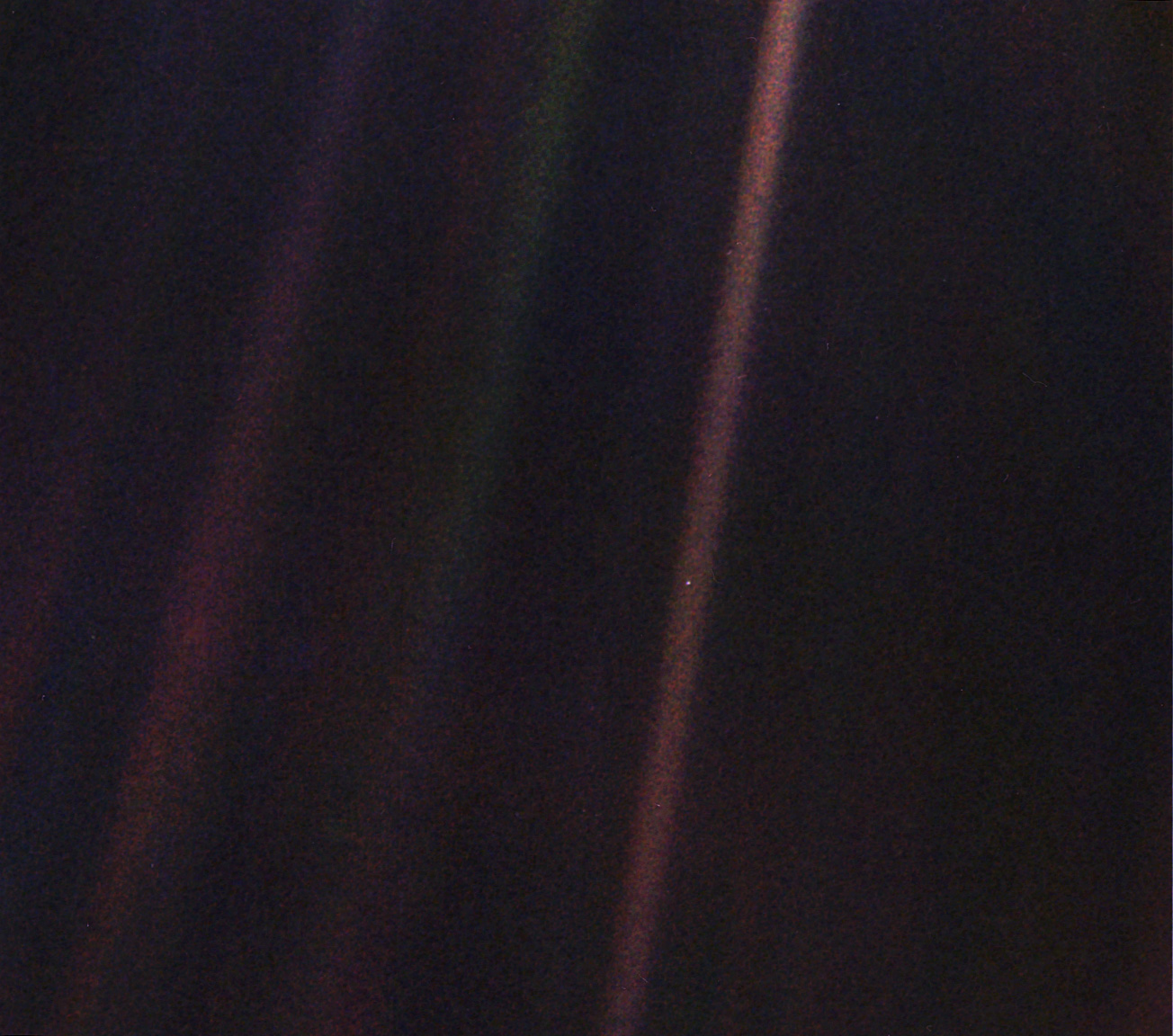
Original (1990)
jpg (414.21 KB)
Pale Blue Dot Revisited (2020)
tif (29.85 MB)

Suggested Searches
- Climate Change
- Expedition 64
- Mars perseverance
- SpaceX Crew-2
- International Space Station
- View All Topics A-Z
Humans in Space
Earth & climate, the solar system, the universe, aeronautics, learning resources, news & events.

NASA Receives 13 Nominations for the 28th Annual Webby Awards
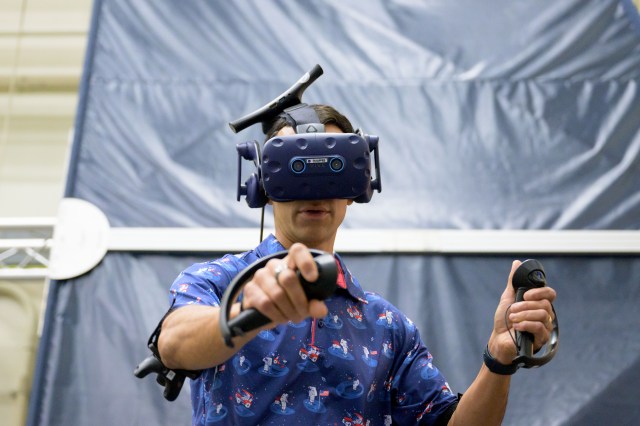
Through Astronaut Eyes, Virtual Reality Propels Gateway Forward

How NASA Spotted El Niño Changing the Saltiness of Coastal Waters
- Search All NASA Missions
- A to Z List of Missions
- Upcoming Launches and Landings
- Spaceships and Rockets
- Communicating with Missions
- James Webb Space Telescope
- Hubble Space Telescope
- Why Go to Space
- Astronauts Home
- Commercial Space
- Destinations
- Living in Space
- Explore Earth Science
- Earth, Our Planet
- Earth Science in Action
- Earth Multimedia
- Earth Science Researchers
- Pluto & Dwarf Planets
- Asteroids, Comets & Meteors
- The Kuiper Belt
- The Oort Cloud
- Skywatching
- The Search for Life in the Universe
- Black Holes
- The Big Bang
- Dark Energy & Dark Matter
- Earth Science
- Planetary Science
- Astrophysics & Space Science
- The Sun & Heliophysics
- Biological & Physical Sciences
- Lunar Science
- Citizen Science
- Astromaterials
- Aeronautics Research
- Human Space Travel Research
- Science in the Air
- NASA Aircraft
- Flight Innovation
- Supersonic Flight
- Air Traffic Solutions
- Green Aviation Tech
- Drones & You
- Technology Transfer & Spinoffs
- Space Travel Technology
- Technology Living in Space
- Manufacturing and Materials
- Science Instruments
- For Kids and Students
- For Educators
- For Colleges and Universities
- For Professionals
- Science for Everyone
- Requests for Exhibits, Artifacts, or Speakers
- STEM Engagement at NASA
- NASA's Impacts
- Centers and Facilities
- Directorates
- Organizations
- People of NASA
- Internships
- Our History
- Doing Business with NASA
- Get Involved
- Aeronáutica
- Ciencias Terrestres
- Sistema Solar
- All NASA News
- Video Series on NASA+
- Newsletters
- Social Media
- Media Resources
- Upcoming Launches & Landings
- Virtual Events
- Sounds and Ringtones
- Interactives
- STEM Multimedia

Hubble Spots a Galaxy Hidden in a Dark Cloud


Altitude Chamber Gets Upgrade for Artemis II, Spacecraft Testing Begins
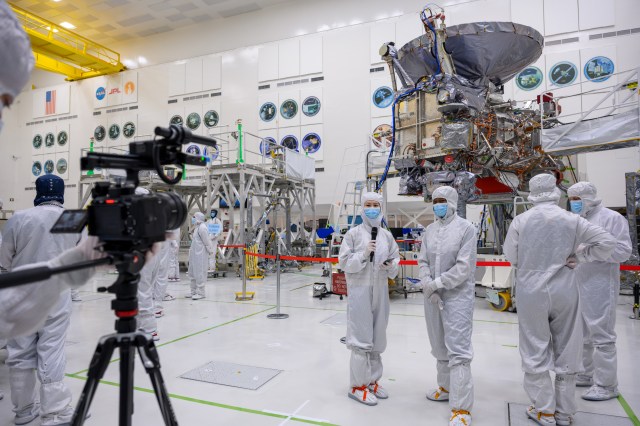
Media Get Close-Up of NASA’s Jupiter-Bound Europa Clipper

NASA Shares Medical Expertise with New Space Station Partners

From NASA’s First Astronaut Class to Artemis II: The Importance of Military Jet Pilot Experience
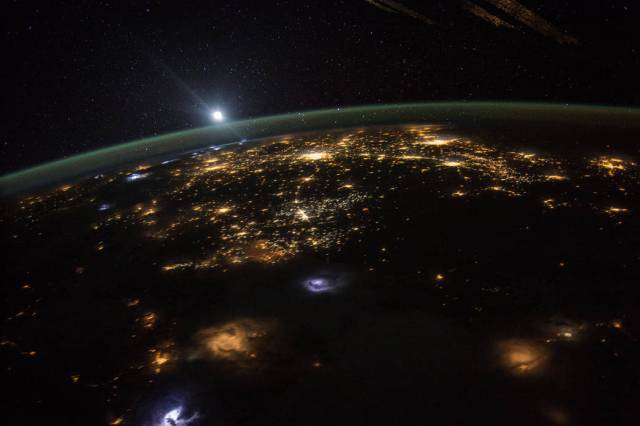
Commercial Space Frequently Asked Questions

NASA’s PACE Data on Ocean, Atmosphere, Climate Now Available

NASA’s Lola Fatoyinbo Receives Royal Geographical Society Prize

More Than 36,000 Volunteers Helped Do NASA Eclipse Science

NASA Names Finalists of the Power to Explore Challenge

NASA’s TESS Temporarily Pauses Science Observations

Accelerating Informatics for Earth Science

NASA Langley Team to Study Weather During Eclipse Using Uncrewed Vehicles

NASA Noise Prediction Tool Supports Users in Air Taxi Industry

ARMD Solicitations

NASA’s SERT II: ‘A Genuine Space Success Story’

Tech Today: Synthetic DNA Diagnoses COVID, Cancer

NASA Partnerships Bring 2024 Total Solar Eclipse to Everyone

Launch Week Event Details

La presentación del X-59 de la NASA personifica la tradición aeronáutica
40 years ago: voyager 1 explores saturn, johnson space center.
Today, Voyager 1 is the most distant spacecraft from Earth, more than 14 billion miles away and continuing on its journey out of our solar system. Forty years ago, it made its closest approach to Saturn. Although it was not the first to explore the giant ringed planet, as the Pioneer 11 spacecraft completed the first flyby in 1979, Voyager carried sophisticated instruments to conduct more in-depth investigations. NASA’s Jet Propulsion Laboratory in Southern California managed the two Voyager spacecraft launched in 1977 to explore Jupiter and Saturn. Voyager 2 went on to investigate Uranus and Neptune as well, taking advantage of a rare planetary alignment that occurs once every 175 years that enabled the spacecraft to use the gravity of one planet to redirect it to the next.
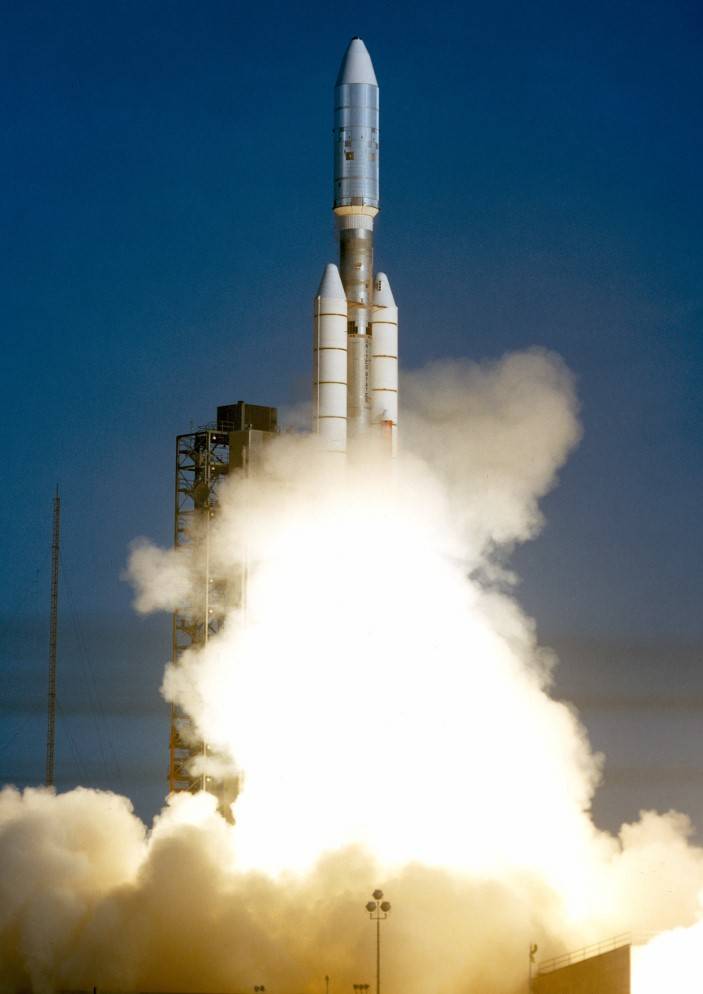
To carry out its studies during the planetary encounters as well as while cruising through interplanetary space, Voyager 1 carried a suite of 11 instruments, including:
- an imaging science system consisting of narrow-angle and wide-angle cameras to photograph the planets and their satellites;
- a radio science system to determine the planets’ physical properties;
- an infrared interferometer spectrometer to investigate local and global energy balance and atmospheric composition;
- an ultraviolet spectrometer to measure atmospheric properties;
- a magnetometer to analyze the planets’ magnetic fields and interactions with the solar wind;
- a plasma spectrometer to investigate microscopic properties of plasma ions;
- a low energy charged particle device to measure fluxes and distributions of ions;
- a cosmic ray detection system to determine the origin and behavior of cosmic radiation;
- a planetary radio astronomy investigation to study radio emissions from Jupiter;
- a photopolarimeter to measure the planets’ surface compositions; and
- a plasma wave system to study the planets’ magnetospheres.
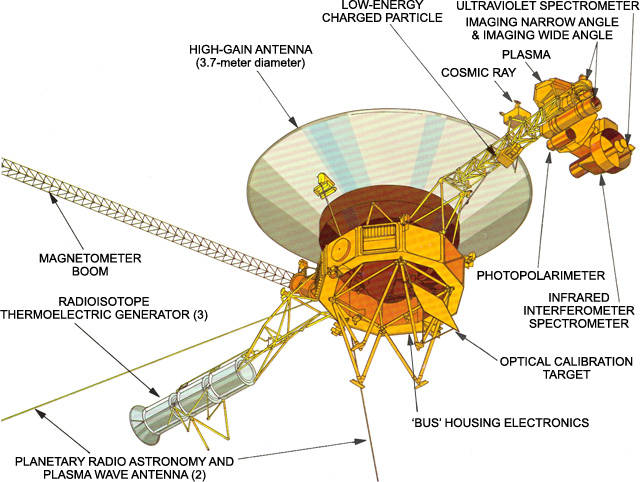
Two weeks after its launch from the Cape Canaveral Air Force Station in Florida on Sep. 5, 1977, Voyager 1 turned its cameras back toward its home planet and took the first single-frame image of the Earth-Moon system, providing a taste of future discoveries at the outer planets. The spacecraft crossed the asteroid belt without incident between Dec. 10, 1977, and Sep. 8, 1978, and flew by Jupiter on March 5, 1979. During the four-month encounter, Voyager 1 returned 19,000 photographs of the giant planet, its four largest satellites, discovered two new moons, and found a thin ring encircling Jupiter. The spacecraft’s instruments recorded a wealth of scientific data that greatly expanded our knowledge of the planet. After a 17-month interplanetary cruise, Voyager 1 began its Saturn observations on Aug. 22, 1980, still 68 million miles from the planet. Because of its interest to scientists, mission planners chose the spacecraft’s trajectory to make a close flyby of Saturn’s largest moon Titan, the only planetary satellite with a dense atmosphere, just before the closest approach to the planet itself. This trajectory meant that Voyager 1 would pass over Saturn’s south pole and the gravity assist would send it out of the ecliptic, the plane where the solar system’s planets reside, thus precluding further planetary encounters.
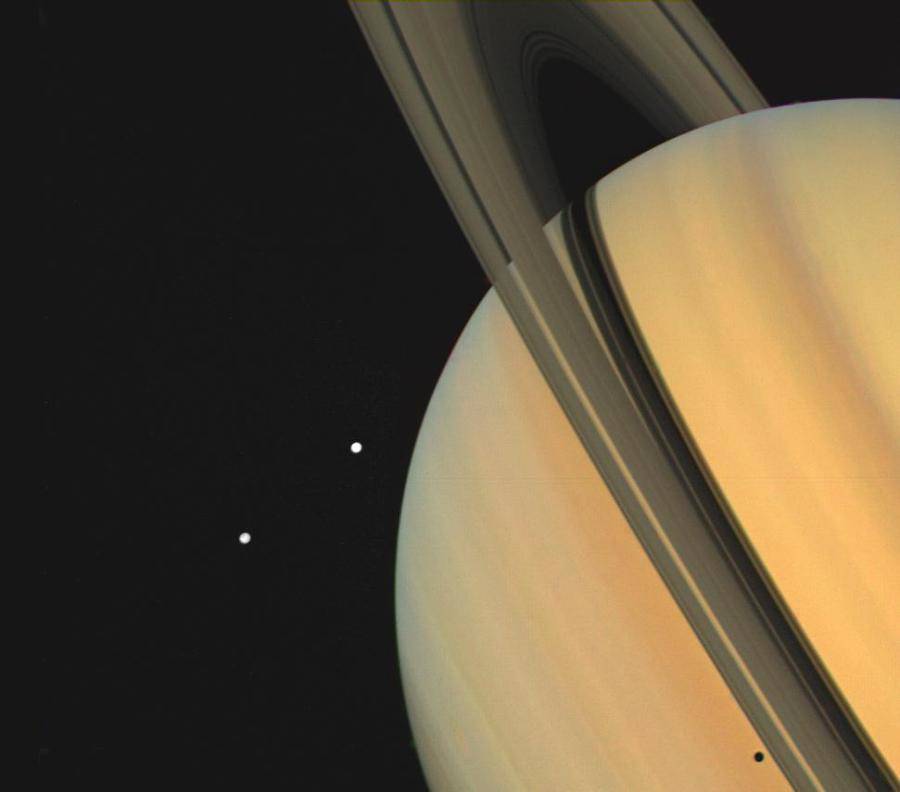
During its approach to Saturn, Voyager 1 returned spectacular images of the planet and ever-more detailed photographs of its rings. These revealed structural features of the various rings, indicating distinctive compositions of each, in particular with regard to particle size. The broad rings easily identifiable from Earth were seen to be composed of thousands of smaller ringlets. Observations of the outer F-ring, discovered by Pioneer 11 the previous year, showed it to have a braided pattern, its small particles perturbed by two newly discovered co-orbiting shepherd moons. Images of Saturn’s atmosphere showed it to be more dynamic than previously expected. Voyager’s instruments indicated that the planet’s atmosphere is composed mainly of hydrogen, with about 11% helium and traces of other gases. The spacecraft observed wind velocities of up 1,100 miles per hour and precisely measured the planet’s rotation at 10 hours and 39.4 minutes.
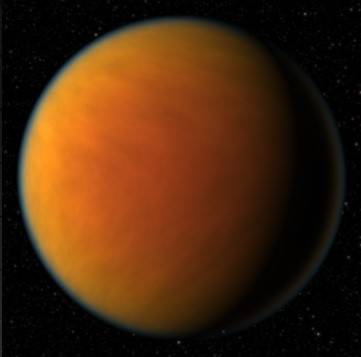
On Nov. 12, about 18 hours before making its closest encounter with Saturn, Voyager 1 turned its attention to one of the high-priority science targets of the encounter, Titan, passing within 4,034 miles of the planet’s largest moon. The spacecraft’s cameras observed an orange haze obscuring the planet’s surface, with detached haze layers up to 300 miles above the thicker atmosphere. The instruments measured the atmospheric composition at the surface as mostly nitrogen with about 10% methane and traces of hydrocarbons, the pressure at the surface 60% greater than Earth’s mean sea level pressure, and surface temperatures around 93 K (-293 degrees Fahrenheit). Voyager 1 measured Titan’s diameter at 3,194 miles and determined its density indicated a composition of roughly equal proportions of rock and water ice. The spacecraft then made its closest approach of 78,000 miles to Saturn’s cloud tops, swung behind the planet, and began its outbound journey. Saturn’s gravity imparted enough acceleration on Voyager 1 that it achieved escape velocity from the solar system.
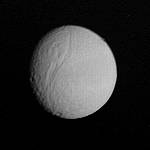
Voyager 1 studied many of Saturn’s smaller icy moons during the encounter and discovered three new ones, bringing the total number of known satellites at the time to 15. In order of study during the encounter and the closest distance to the spacecraft, these moons were: Tethys (258,340 miles), Mimas (54,965 miles), Enceladus (125,570 miles), Dione (100,000 miles), Rhea (45,980 miles), and Hyperion (547,200 miles). These moons range in size from 950 miles in diameter for Rhea to 180-mile-wide Hyperion. Voyager also observed 900-mile-wide outer icy moon Iapetus from a distance of 1.5 million miles. These moons are composed of a mixture of ice and rock, and most show heavily cratered surfaces with the exception of Enceladus. Iapetus displays two very different hemispheres, a dark leading side, and a much brighter trailing side, while the unique surface feature on Mimas is a large crater one-third the diameter of the moon itself.
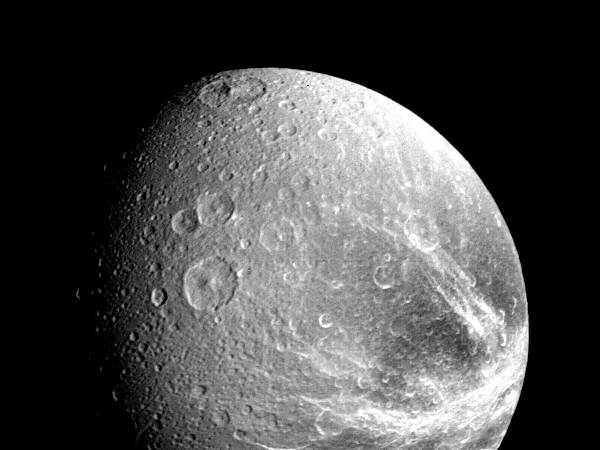
Four days after its closest approach, the spacecraft took a magnificent image of Saturn and its rings from a perspective never seen from Earth, the planet in a crescent phase with its night side dimly illuminated by ring-shine, sunlight reflected from the rings. Voyager 1 completed its observations of the Saturn system on Dec. 14, 1980.
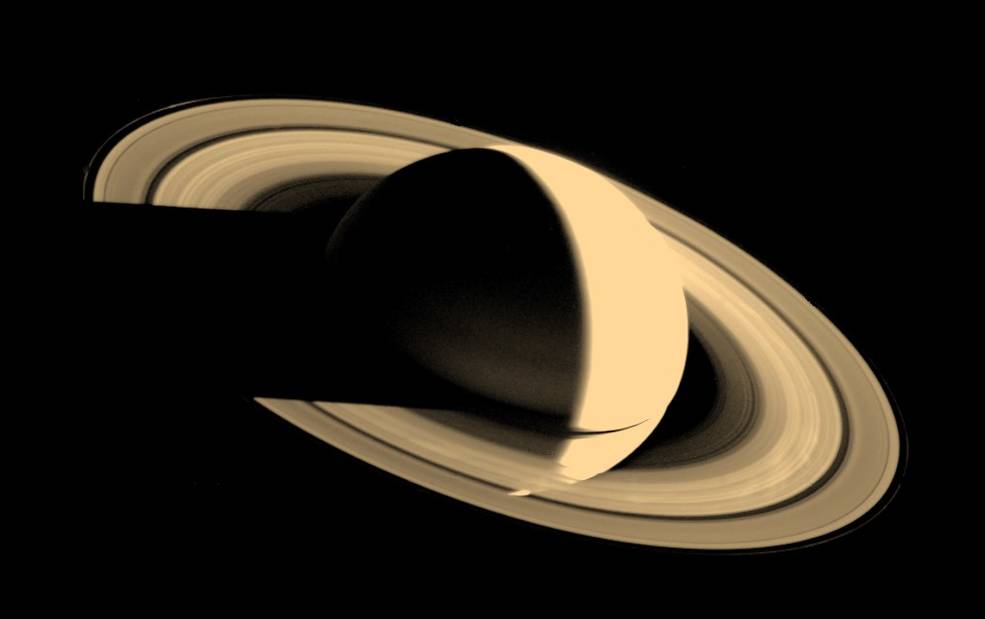
On Feb. 14, 1990, more than 12 years after it began its journey from Earth and shortly before its cameras were permanently turned off to conserve power, Voyager 1 spun around and pointed them back into the solar system. In a mosaic of 60 images, it captured a “family portrait” of six of the solar system’s planets, including a pale blue dot called Earth more than 3.7 billion miles away. Fittingly, these were the last pictures returned from either Voyager spacecraft. In February 2020, to commemorate the photograph’s 30th anniversary, NASA released a remastered version of the image of Earth as Pale Blue Dot Revisited .

In August 2012, the spacecraft passed beyond the heliopause, the boundary between the heliosphere, the bubble-like region of space created by the Sun, and the interstellar medium. Now, more than 43 years after its launch, several of Voyager 1’s instruments are still returning useful data about conditions beyond the solar system. Engineers expect that Voyager 1 will continue to return data from interstellar space until about 2025 when it will no longer be able to power its instruments. Just in case an alien intelligence should find it one day, Voyager 1 and its twin carry gold-plated records that contain information about its home planet, including recordings of terrestrial sounds, music, and greetings in 55 languages. Instructions on how to play the record are also included.
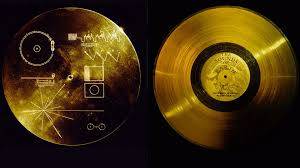
'Pale Blue Dot' Images Turn 25

NASA's Voyager 1 spacecraft showed its love for the solar system, including Earth, with these images on Feb. 14, 1990.
Valentine's Day is special for NASA's Voyager mission. It was on Feb. 14, 1990, that the Voyager 1 spacecraft looked back at our solar system and snapped the first-ever pictures of the planets from its perch at that time beyond Neptune.
This "family portrait" captures Neptune, Uranus, Saturn, Jupiter, Earth and Venus from Voyager 1's unique vantage point. A few key members did not make it in: Mars had little sunlight, Mercury was too close to the sun, and dwarf planet Pluto turned out too dim.
Taking these images was not part of the original plan, but the late Carl Sagan, a member of the Voyager imaging team at the time, had the idea of pointing the spacecraft back toward its home for a last look. The title of his 1994 book, "Pale Blue Dot," refers to the image of Earth in this series.
"Twenty-five years ago, Voyager 1 looked back toward Earth and saw a 'pale blue dot,' " an image that continues to inspire wonderment about the spot we call home," said Ed Stone, project scientist for the Voyager mission, based at the California Institute of Technology, Pasadena.
The image of Earth contains scattered light that resembles a beam of sunlight, which is an artifact of the camera itself that makes the tiny Earth appear even more dramatic. Voyager 1 was 40 astronomical units from the sun at this moment. One astronomical unit is 93 million miles, or 150 million kilometers.
These family portrait images are the last that Voyager 1, which launched in 1977, returned to Earth. Mission specialists subsequently turned the camera off so that the computer controlling it could be repurposed. The spacecraft is still operating, but no longer has the capability to take images.
"After taking these images in 1990, we began our interstellar mission. We had no idea how long the spacecraft would last," Stone said.
Today, Voyager 1, at a distance of 130 astronomical units, is the farthest human-made object from Earth, and it still regularly communicates with our planet. In August 2012, the spacecraft entered interstellar space - the space between the stars -- and has been delivering data about this uncharted territory ever since. Its twin, Voyager 2, also launched in 1977, is also journeying toward interstellar space.
Voyager 1 is more than three times farther from Earth than it was on Valentine's Day 25 years ago. Today, Earth would appear about 10 times dimmer from Voyager's vantage point.
Sagan wrote in his "Pale Blue Dot" book: "That's here. That's home. That's us. On it everyone you love, everyone you know, everyone you ever heard of, every human being who ever was, lived out their lives. ... There is perhaps no better demonstration of the folly of human conceits than this distant image of our tiny world."
A video clip of Ann Druyan, Carl Sagan's co-author and widow, discussing the pale blue dot image, is available at:
http://www.jpl.nasa.gov/video/details.php?id=1363
NASA's Jet Propulsion Laboratory, Pasadena, California, built and operates the twin Voyager spacecraft. The Voyagers Interstellar Mission is a part of NASA's Heliophysics System Observatory, sponsored by the Heliophysics Division of NASA's Science Mission Directorate in Washington.
For more information about Voyager, visit:
http://voyager.jpl.nasa.gov
News Media Contact
Elizabeth Landau
Headquarters, Washington
202-358-0845
- Mobile Site
- Staff Directory
- Advertise with Ars
Filter by topic
- Biz & IT
- Gaming & Culture
Front page layout
Hope returns —
Nasa knows what knocked voyager 1 offline, but it will take a while to fix, "engineers are optimistic they can find a way for the fds to operate normally.".
Stephen Clark - Apr 6, 2024 12:28 am UTC
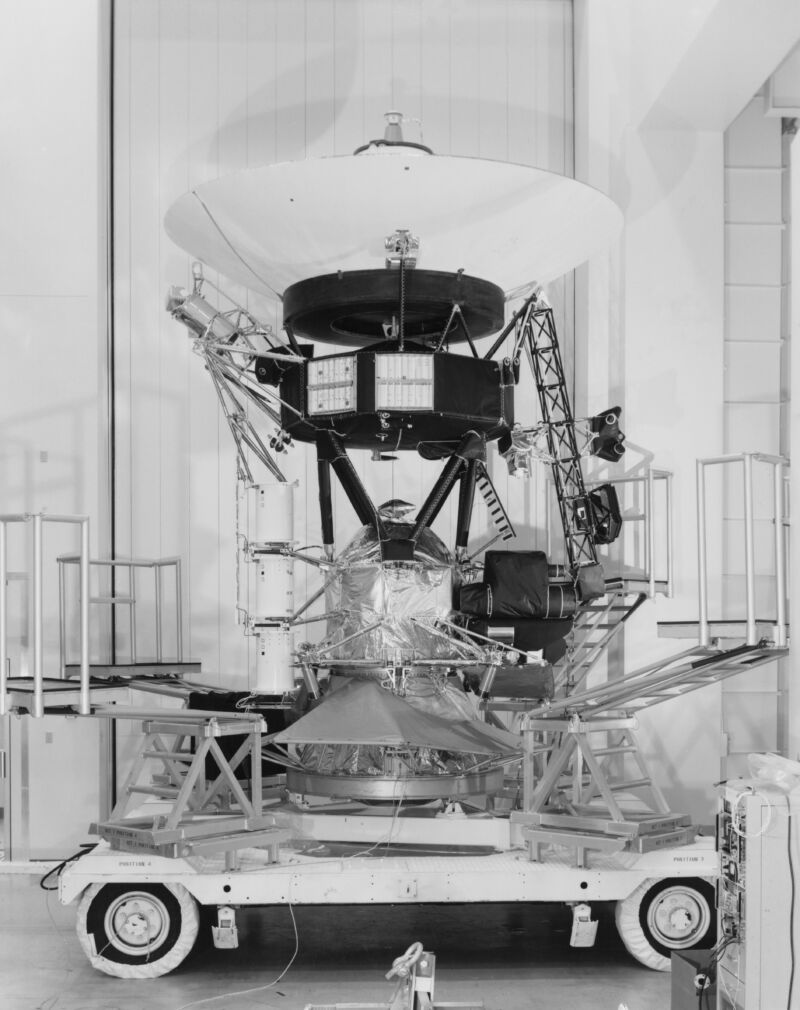
Engineers have determined why NASA's Voyager 1 probe has been transmitting gibberish for nearly five months, raising hopes of recovering humanity's most distant spacecraft.
Voyager 1, traveling outbound some 15 billion miles (24 billion km) from Earth, started beaming unreadable data down to ground controllers on November 14. For nearly four months, NASA knew Voyager 1 was still alive—it continued to broadcast a steady signal—but could not decipher anything it was saying.
Confirming their hypothesis, engineers at NASA's Jet Propulsion Laboratory (JPL) in California confirmed a small portion of corrupted memory caused the problem. The faulty memory bank is located in Voyager 1's Flight Data System (FDS), one of three computers on the spacecraft. The FDS operates alongside a command-and-control central computer and another device overseeing attitude control and pointing.
The FDS duties include packaging Voyager 1's science and engineering data for relay to Earth through the craft's Telemetry Modulation Unit and radio transmitter. According to NASA, about 3 percent of the FDS memory has been corrupted, preventing the computer from carrying out normal operations.
Optimism growing
Suzanne Dodd, NASA's project manager for the twin Voyager probes, told Ars in February that this was one of the most serious problems the mission has ever faced. That is saying something because Voyager 1 and 2 are NASA's longest-lived spacecraft. They launched 16 days apart in 1977, and after flying by Jupiter and Saturn, Voyager 1 is flying farther from Earth than any spacecraft in history. Voyager 2 is trailing Voyager 1 by about 2.5 billion miles, although the probes are heading out of the Solar System in different directions.
Normally, engineers would try to diagnose a spacecraft malfunction by analyzing data it sent back to Earth. They couldn't do that in this case because Voyager 1 has been transmitting data packages manifesting a repeating pattern of ones and zeros. Still, Voyager 1's ground team identified the FDS as the likely source of the problem.
The Flight Data Subsystem was an innovation in computing when it was developed five decades ago. It was the first computer on a spacecraft to use volatile memory. Most of NASA's missions operate with redundancy, so each Voyager spacecraft launched with two FDS computers. But the backup FDS on Voyager 1 failed in 1982.
Due to the Voyagers' age, engineers had to reference paper documents, memos, and blueprints to help understand the spacecraft's design details. After months of brainstorming and planning, teams at JPL uplinked a command in early March to prompt the spacecraft to send back a readout of the FDS memory.
The command worked, and Voyager1 responded with a signal different from the code it had been transmitting since November. After several weeks of meticulous examination of the new code, engineers pinpointed the location of the bad memory.
"The team suspects that a single chip responsible for storing part of the affected portion of the FDS memory isn’t working," NASA said in an update posted Thursday. "Engineers can’t determine with certainty what caused the issue. Two possibilities are that the chip could have been hit by an energetic particle from space or that it simply may have worn out after 46 years."
Voyager 1's distance from Earth complicates the troubleshooting effort. The one-way travel time for a radio signal to reach Voyager 1 from Earth is about 22.5 hours, meaning it takes roughly 45 hours for engineers on the ground to learn how the spacecraft responded to their commands.
NASA also must use its largest communications antennas to contact Voyager 1. These 230-foot-diameter (70-meter) antennas are in high demand by many other NASA spacecraft , so the Voyager team has to compete with other missions to secure time for troubleshooting. This means it will take time to get Voyager 1 back to normal operations.
"Although it may take weeks or months, engineers are optimistic they can find a way for the FDS to operate normally without the unusable memory hardware, which would enable Voyager 1 to begin returning science and engineering data again," NASA said.
reader comments
Channel ars technica.

Here are the best photos of the April 8 total solar eclipse over North America
Millions of viewers across Mexico and North America witnessed a historic total solar eclipse on April 8, 2024. Here are some of the best photos from the day, including photos of totality, the sun's corona, and the diamond ring effect.
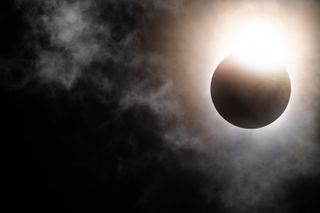
On April 8, 2024, a total solar eclipse drew its enormous shadow over North America, cutting a 115-mile-wide (185 kilometers), 10,000-mile-long (16,000 km) path of sudden darkness across the continent.
Starting in Mexico, the eclipse moved through 15 U.S. states before passing across Canada , and was visible to an estimated 44 million people. If you didn't catch the stunning spectacle in person, here are all of our favorite photos taken from eclipse watching parties throughout the Americas.
Related: No, you didn't see a solar flare during the total eclipse — but you may have seen something just as special
The first totality began in Mazatlán, Mexico, where onlookers saw the moon pass in front of the solar disk. Just before totality, viewers were treated to a thin diamond-like ring of sunlight shimmering through valleys on the moon's outer surface.
After the moon had completely blocked off the sun's face, all that could be seen were thin purple plumes in the corona caused by solar eruptions.
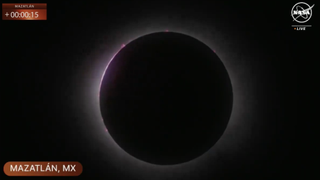
Meanwhile, the moon began to carve the sun into a toenail-thin sliver above Fort Worth, Texas.
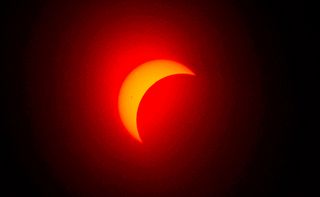
Then, just before totality, the diamond ring effect could be seen. As the final beads of sunlight zipped through the valleys on the moon's limb, the two bodies appeared in the sky as a ring studded with brilliant diamonds.
Sign up for the Live Science daily newsletter now
Get the world’s most fascinating discoveries delivered straight to your inbox.
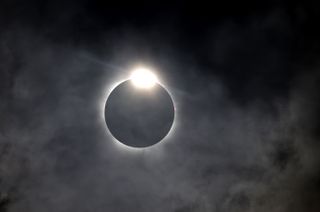
Later, in space, the European Space Agency 's Geostationary Operational Environmental Satellite captured the shadow of the moon sweeping across North America.
The eclipse passed over Cleveland, Ohio, where the Chicago White Sox and the Cleveland Guardians were just about to face off. Baseball fans and players alike flocked to the field to capture photos of the eclipse; this image shows a composite of the partial and total phases of the eclipse as seen from Progressive Field.

During totality, the sun's corona shone in the darkened sky, high above the stadium lights at Progressive Field in Cleveland, Ohio.
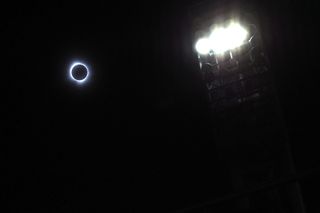
When the eclipse passed over Dallas, Texas, a NASA photographer caught the entire progression on camera. This composite image shows both partial phases of the eclipse on the left and right, with the corona visible during the moment of totality in the center.

Solar prominences (enormous loops of plasma that tower over the sun's surface) were visible during totality to those with telescopes and telephoto cameras. Each prominence is many times taller than Earth.

The partial phases of the eclipse were visible over the Washington Monument in Washington, D.C., as this composite NASA image shows.
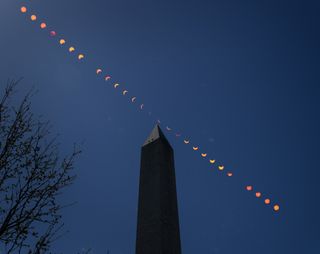
The final rays of the sun peeked over the mountians of the moon just seconds before totality began in Indianapolis, Indiana.

Clouds obscured much of the total phase of the eclipse at Niagara Falls, where millions of people flocked to both the U.S. an Canadian sides of the river to witness the spectacle. While the corona is obscured in this image, the horizon glows with the 360-degree sunset effect that's synonymous with totality.

Not far away in Hamilton, Ontario, eclipse chasers flocked to the edge of Lake Ontario for a view of totality. Here, the partial phase of the eclipse begins above a haze of clouds, as seen through a pair of orange-tinted solar eclipse glasses.
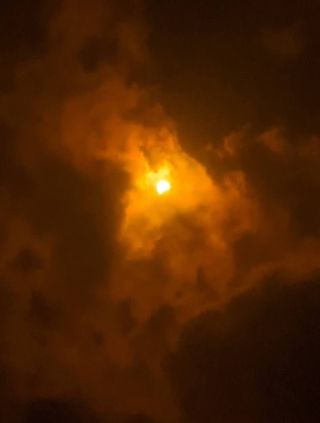
The sun's corona shines in the dark sky during totality over Glover, Vermont.

No less spectacular is Mizar the dog, who awaited the total solar eclipse at the Sacre Coeur de Beauvoir Sanctuary in Sherbrook, Canada.
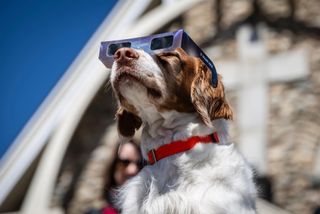
The eclipse bathed the sky in ethereal light above Torreon, Mexico.

The moon descending upon the sun created the conditions for this moody photograph, taken through cloud cover, in Brady, Texas.
Only the slenderest hair of sunlight remains in this photo from Eagle Pass, Texas

Under a blanket of clouds, the moon pockets the sun beneath the angel atop Princes' Gates in Toronto.
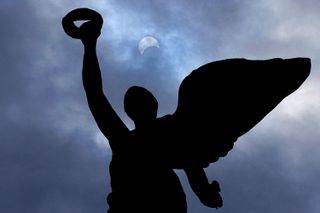
The partial solar eclipse seen through cloud cover at Niagara Falls, New York.
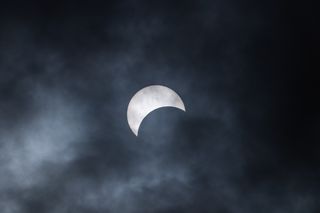
The moon passes in front of the sun behind the Washington Monument during the partial solar eclipse in Washington DC.

The partial solar eclipse stuns among billowing clouds atop the dome of the U.S Capitol Building on Capitol Hill in Washington DC.
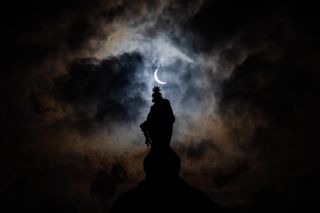
The sun reaches totality in Houlton, Maine, before passing over New Brunswick, then Newfoundland and out into the Atlantic ocean.
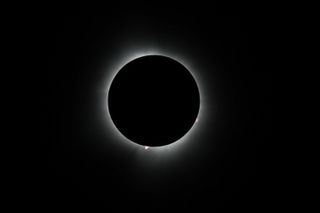
Ben Turner is a U.K. based staff writer at Live Science. He covers physics and astronomy, among other topics like tech and climate change. He graduated from University College London with a degree in particle physics before training as a journalist. When he's not writing, Ben enjoys reading literature, playing the guitar and embarrassing himself with chess.
Uranus and Neptune aren't made of what we thought, new study hints
Why I watched the solar eclipse with my kids, a goose and 2,000 trees
Parasite that lived in woman's eye for 2 years likely came from crocodile meat
Most Popular
By Ben Turner April 10, 2024
By Elise Poore April 10, 2024
By Harry Baker April 10, 2024
By Tom Metcalfe April 10, 2024
By Sascha Pare April 10, 2024
By Peter Ray Allison April 10, 2024
By Tom Metcalfe April 09, 2024
By Rebecca Sohn April 09, 2024
By Stephanie Pappas April 09, 2024
By Samantha Mathewson April 09, 2024
By Nicoletta Lanese April 09, 2024
- 2 Here are the best photos of the April 8 total solar eclipse over North America
- 3 Part of the San Andreas fault may be gearing up for an earthquake
- 4 Pet fox with 'deep relationship with the hunter-gatherer society' buried 1,500 years ago in Argentina
- 5 NASA engineers discover why Voyager 1 is sending a stream of gibberish from outside our solar system
- 2 No, you didn't see a solar flare during the total eclipse — but you may have seen something just as special
- 3 Pet fox with 'deep relationship with the hunter-gatherer society' buried 1,500 years ago in Argentina
- 4 Eclipse from space: See the moon's shadow race across North America at 1,500 mph in epic satellite footage
- 5 Superfast drone fitted with new 'rotating detonation rocket engine' approaches the speed of sound
We finally know why NASA's Voyager 1 spacecraft stopped communicating — scientists are working on a fix
The first spacecraft to explore beyond the solar system started spouting gibberish late last year. Now, NASA knows why.

NASA engineers have discovered the cause of a communications breakdown between Earth and the interstellar explorer Voyager 1. It would appear that a small portion of corrupted memory exists in one of the spacecraft's computers.
The glitch caused Voyager 1 to send unreadable data back to Earth, and is found in the NASA spacecraft's flight data subsystem (FDS). That's the system responsible for packaging the probe's science and engineering data before the telemetry modulation unit (TMU) and radio transmitter send it back to mission control.
The source of the issue began to reveal itself when Voyager 1 operators sent the spacecraft a "poke" on March 3, 2024. This was intended to prompt FDS to send a full memory readout back to Earth.
The readout confirmed to the NASA team that about 3% of the FDS memory had been corrupted, and that this was preventing the computer from carrying out its normal operations.
Related: NASA finds clue while solving Voyager 1's communication breakdown case
Launched in 1977, Voyager 1 became the first human-made object to leave the solar system and enter interstellar space in 2012. Voyager 2 followed its spacecraft sibling out of the solar system in 2018, and is still operational and communicating well with Earth.
After 11 years of interstellar exploration, in Nov. 2023, Voyager 1's binary code — the computer language it uses to communicate with Earth — stopped making sense. Its 0's and 1's didn't mean anything anymore.
Get the Space.com Newsletter
Breaking space news, the latest updates on rocket launches, skywatching events and more!
"Effectively, the call between the spacecraft and the Earth was still connected, but Voyager's 'voice' was replaced with a monotonous dial tone," Voyager 1's engineering team previously told Space.com .

The team strongly suspects this glitch is the result of a single chip that's responsible for storing part of the affected portion of the FDS memory ceasing to work.
Currently, however, NASA can’t say for sure what exactly caused that particular issue. The chip could have been struck by a high-speed energetic particle from space or, after 46 years serving Voyager 1, it may simply have worn out.
— Voyager 2: An iconic spacecraft that's still exploring 45 years on
— NASA's interstellar Voyager probes get software updates beamed from 12 billion miles away
— NASA Voyager 2 spacecraft extends its interstellar science mission for 3 more years
Voyager 1 currently sits around 15 billion miles (24 billion kilometers) from Earth, which means it takes 22.5 hours to receive a radio signal from it — and another 22.5 hours for the spacecraft to receive a response via the Deep Space Network's antennas. Solving this communication issue is thus no mean feat.
Yet, NASA scientists and engineers are optimistic they can find a way to help FDS operate normally, even without the unusable memory hardware.
Solving this issue could take weeks or even months, according to NASA — but if it is resolved, Voyager 1 should be able to resume returning science data about what lies outside the solar system.
Join our Space Forums to keep talking space on the latest missions, night sky and more! And if you have a news tip, correction or comment, let us know at: [email protected].

Robert Lea is a science journalist in the U.K. whose articles have been published in Physics World, New Scientist, Astronomy Magazine, All About Space, Newsweek and ZME Science. He also writes about science communication for Elsevier and the European Journal of Physics. Rob holds a bachelor of science degree in physics and astronomy from the U.K.’s Open University. Follow him on Twitter @sciencef1rst.
SpaceX launches advanced weather satellite for US Space Force (video)
SpaceX launches 23 Starlink satellites in nighttime liftoff (photos, video)
Fallout and the Space Age: The franchise's connections and nods to the final frontier
- jcs Funny timing for this article, when I am streaming an old Star Trek movie. So, surely this didn't cause a 3 byte glitch removing the O, Y and A from Voyager's name buffer? Get it? Reply
- bwana4swahili It is quite amazing it has lasted this long in a space environment. Reply
bwana4swahili said: It is quite amazing it has lasted this long in a space environment.
- HankySpanky So now we know even better for next time. Perhaps a spare chipset that is not redundant but is ready to take over, stored in a protective environment. A task NASA can handle. We'll find out in 100 year or so - if humanity still exists. Reply
HankySpanky said: So now we know even better for next time. Perhaps a spare chipset that is not redundant but is ready to take over, stored in a protective environment. A task NASA can handle. We'll find out in 100 year or so - if humanity still exists.
- Classical Motion I'm afraid it might self repair. And download galactic knowledge, then decide we are a danger. And turn around. Reply
Classical Motion said: I'm afraid it might self repair. And download galactic knowledge, then decide we are a danger. And turn around.
- jcs ROFLOL! And a hot bald chick delivering the bad news! Reply
- View All 8 Comments
Most Popular
- 2 Sierra Space wants to drop cargo from orbit to anywhere on Earth in 90 minutes
- 3 DJI Avata 2 drone review
- 4 Scientists identify origin of the 'BOAT' — the brightest cosmic blast of all time
- 5 My formal 2024 solar eclipse apology

The 2024 total solar eclipse captivates America: See stunning photos of the rare event
The 2024 total solar eclipse passed over Earth Monday and the country was enthralled.
The eclipse covered hundreds of cities and towns in a 115-mile wide path of totality across 13 U.S. states, temporarily leaving communities in darkness. Some places will saw totality for about four minutes.
The next time a total eclipse will be visible in the U.S. will be 2044, leaving skywatchers scrambling to save the memory as best they can.
Start the day smarter. Get all the news you need in your inbox each morning.
While the astral event doesn't usually blind people (especially if they wear proper eye protection) there is an easy way to watch the moon pass in front of the sun: Check out the photos below from the USA TODAY Network as the 2024 solar eclipse captivates the country.
Total solar eclipse 2024 live updates: Watch video and see what time it will hit your area
See progression of the 2024 solar eclipse
Stream the 2024 solar eclipse, what is a solar eclipse.
Any celestial object like a moon or a planet that passes between two other bodies can create an eclipse by obscuring the view of objects like the sun.
A total eclipse occurs when the moon appears as the same size as the sun and blocks the entire disk from Earth, leading to a period of darkness lasting several minutes. The resulting "totality," whereby observers can see the outermost layer of the sun's atmosphere known as the corona, confuses animals – causing nocturnal creatures to stir and bird and insects to fall silent.
A recent study even found that clouds activity is altered by eclipses as shallow cumulus clouds were observed vanishing when the moon obscured the sun.
This article originally appeared on USA TODAY: The 2024 total solar eclipse captivates America: See stunning photos of the rare event


- The Contents
- The Making of
- Where Are They Now
- Frequently Asked Questions
- Q & A with Ed Stone
golden record
Where are they now.
- frequently asked questions
- Q&A with Ed Stone
Images of Voyager
Get an in-depth look at the science instruments aboard the Voyager spacecraft, plus diagrams illustrating the spacecraft's trajectory, orbit and mechanics. Here you'll also find a number of artist's concepts explaining the anatomy of our solar system and the Voyagers' journey to reach interstellar space.
Image of Voyager.
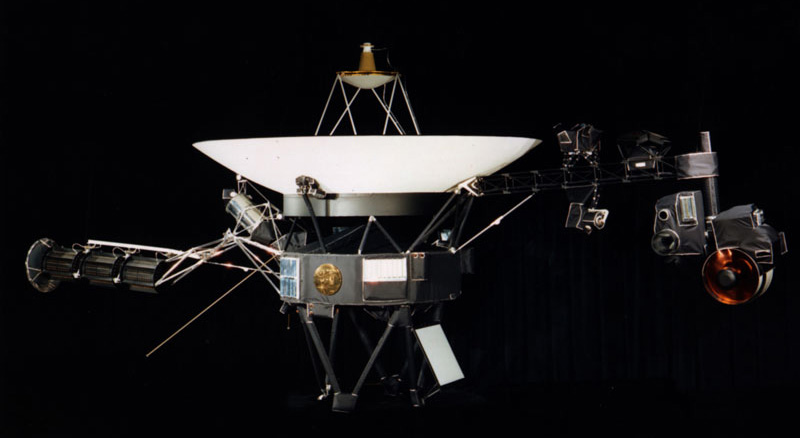
Magnetic mappling coil in Hi-Bay.
Rtg simulator and shipping container., voyager 1’s digital tape recorder.
Credit: NASA/JPL-Caltech

Voyager assembly in Hi-Bay I.
Voyager launch vehicle adapter in saf hi-bay., voyager initial system test at cape canaveral air force station, hangar ao., voyager: antenna dish construction.
This archival photo shows an engineer working on the construction of a large, dish-shaped Voyager high-gain antenna. The picture was taken on July 9, 1976.
Credit: NASA/JPL-Caltech, NASA/JPL-Caltech Photojournal

Voyager Magnetometer Boom Extension testing.
This archival photo shows engineers working with the deployed magnetometer boom of one of NASA’s Voyager spacecraft in Florida on June 17, 1977.
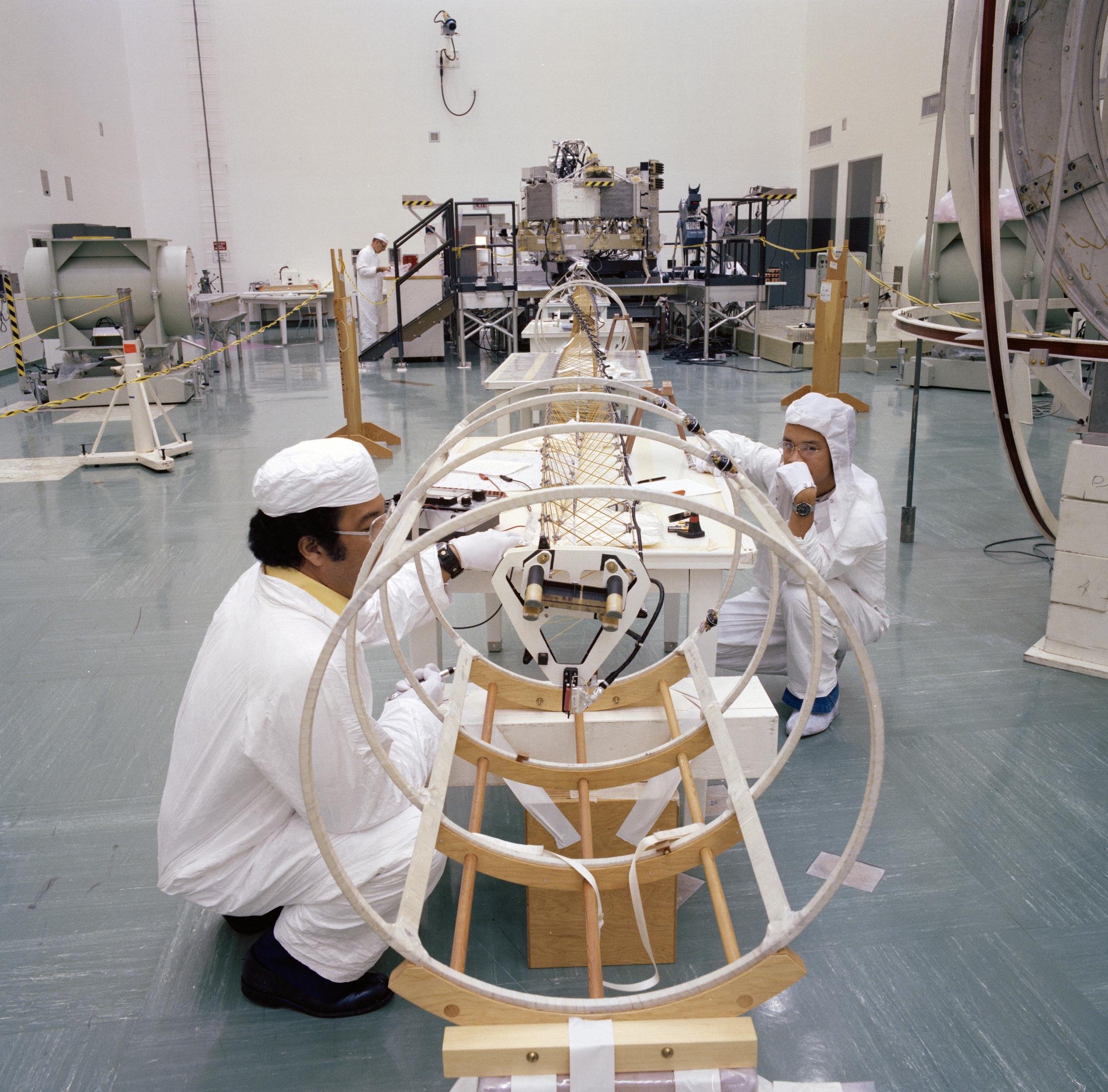
Voyager weight and center of gravity check in Hangar AO at Cape Canaveral Air Force Station.
Voyager in saef ii at kennedy space center., voyager testing.
This image shows one of the Voyagers in the 25-foot space simulator chamber at NASA’s Jet Propulsion Laboratory, Pasadena, California. The photo is dated April 27, 1977.
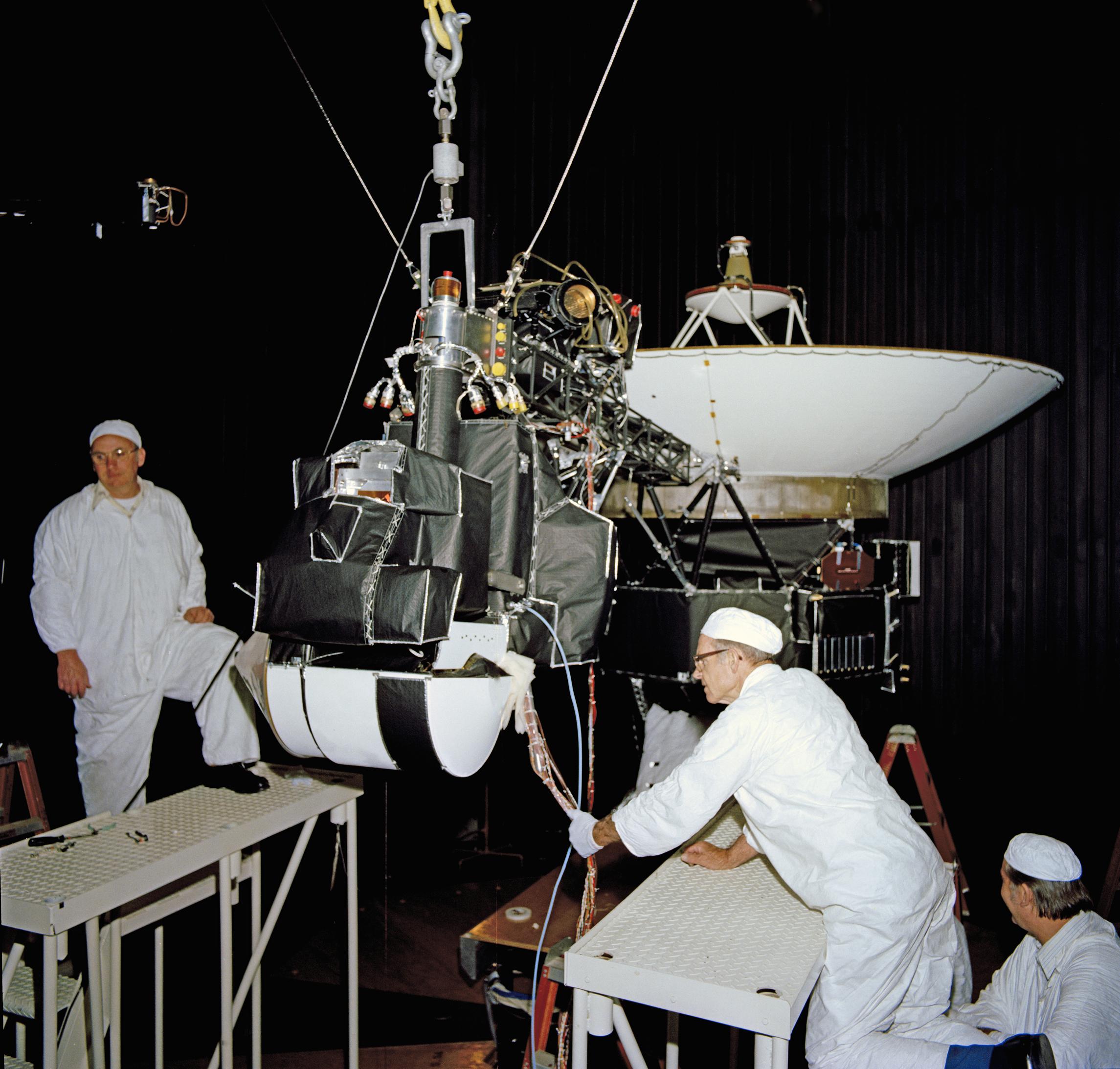
Voyager 2 Testing
This archival photo shows engineers working on NASA’s Voyager 2 spacecraft on March 23, 1977.
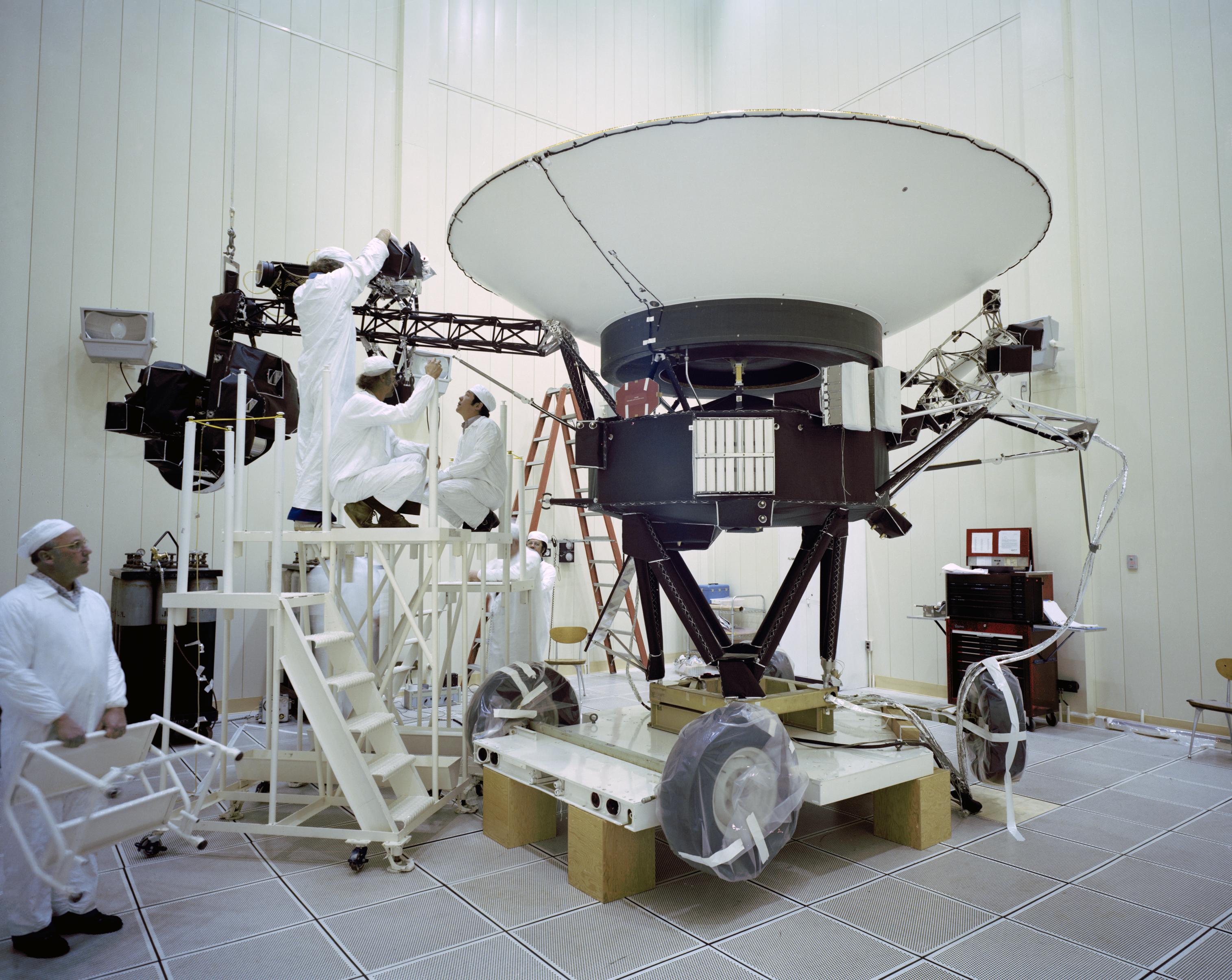
Voyager Test Model Configuration
This archival photo shows the Voyager proof test model, which did not fly in space, in the 25-foot space simulator chamber at NASA’s Jet Propulsion Laboratory, Pasadena, California, on December 3, 1976. The spacecraft is seen here with its scan platform, which holds several of its science instruments, in the deployed position.
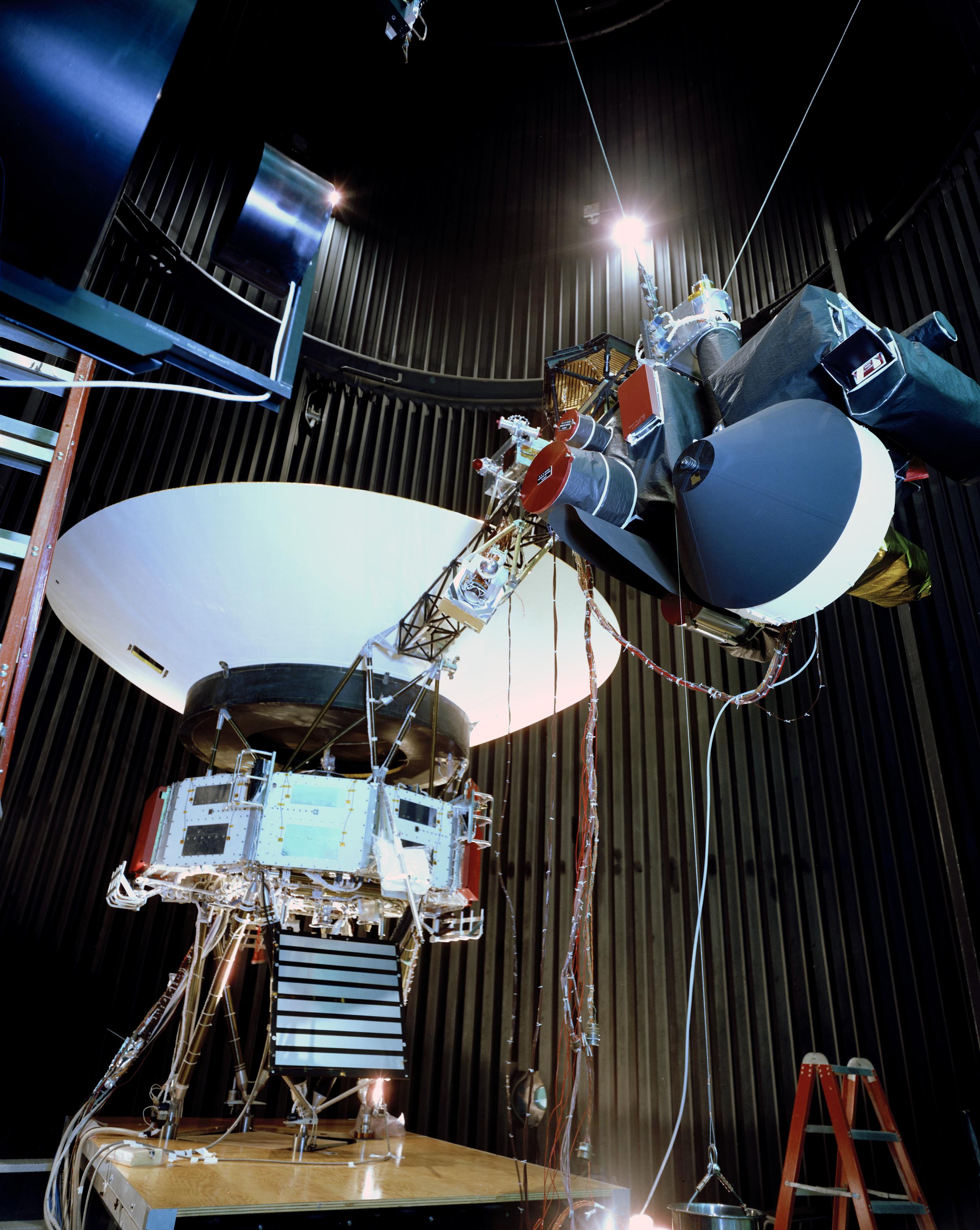
This archival photo shows the Voyager proof test model, which did not fly in space, in the 25-foot space simulator chamber at NASA’s Jet Propulsion Laboratory on December 3, 1976.
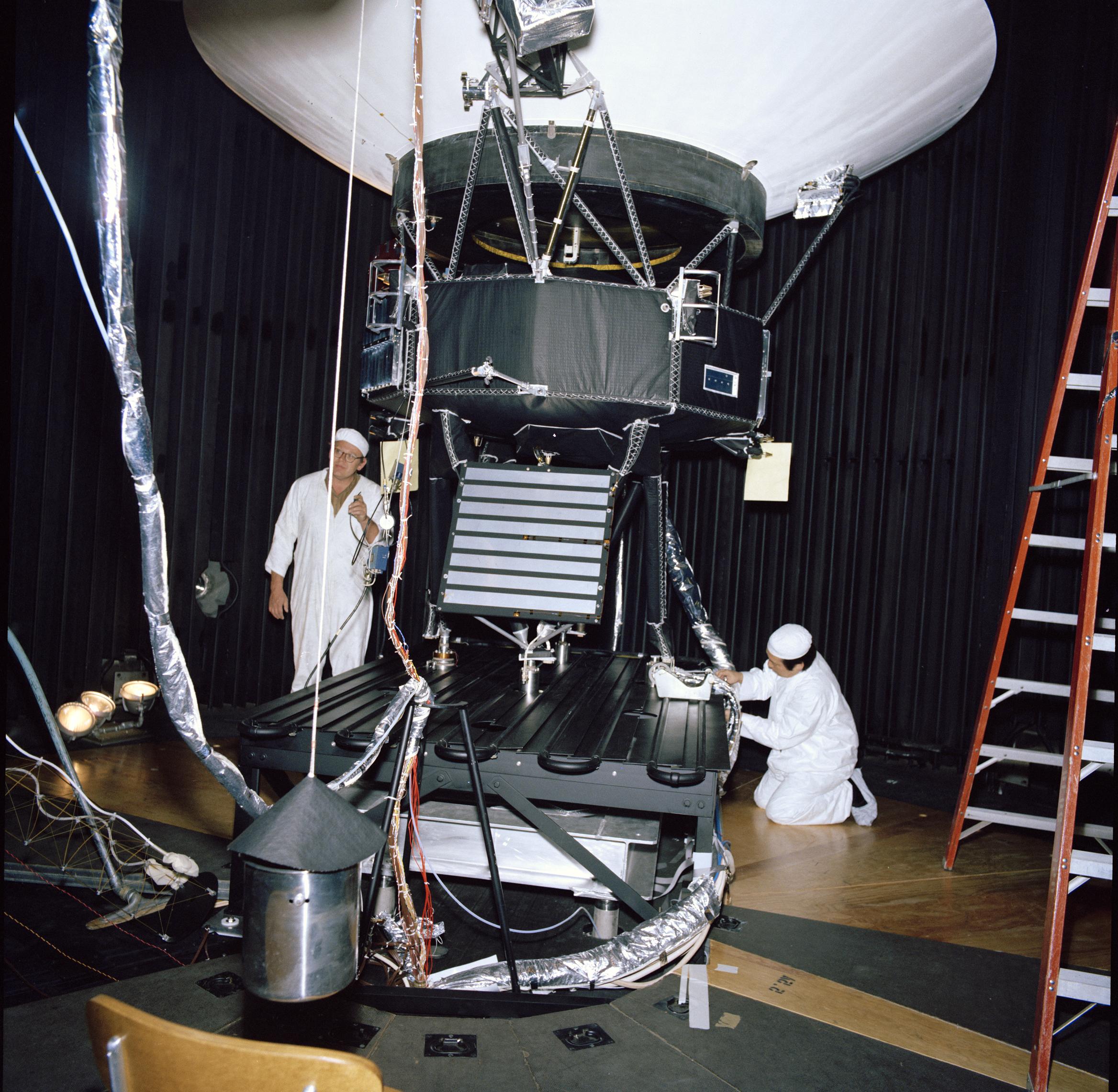
Voyager Proof Test Model
This archival photo shows the Voyager Proof Test Model undergoing a mechanical preparation and weight center of gravity test at NASA’s Jet Propulsion Laboratory, Pasadena, California, on January 12, 1977. The stack of three white cylinders seen near center is a stand-in for the spacecraft’s power generators (called RTGs). Above that, a silvery canister holds the spacecraft’s magnetometer in its stowed configuration.
Credit: NASA/JPL-Caltech/KSC, NASA/JPL-Caltech Photojournal
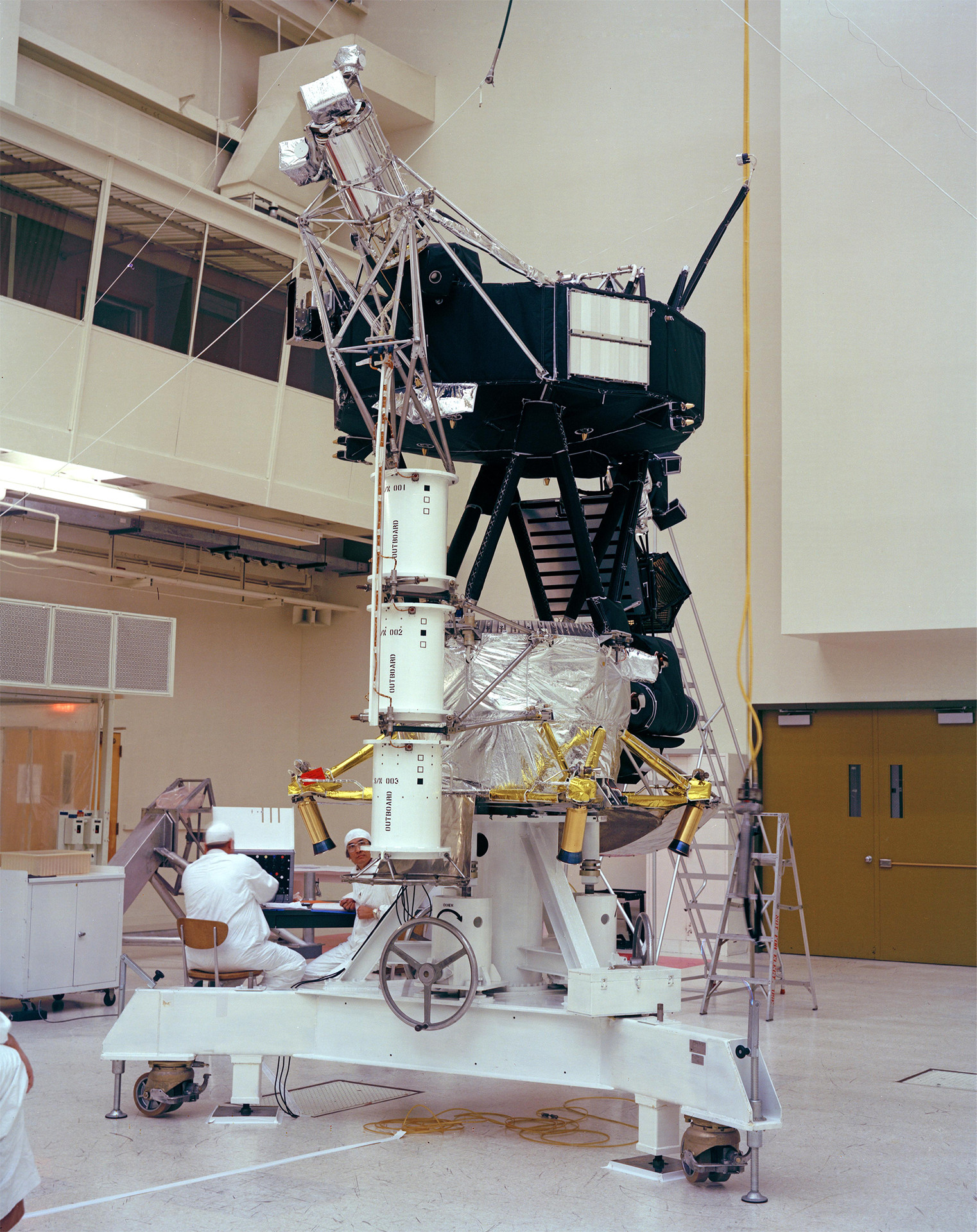
Voyager Proof Test Model and Cleanroom
This archival photo shows the Voyager Proof Test Model (in the foreground right of center) undergoing a mechanical preparation and weight center of gravity test at NASA’s Jet Propulsion Laboratory, Pasadena, California, on January 12, 1977.
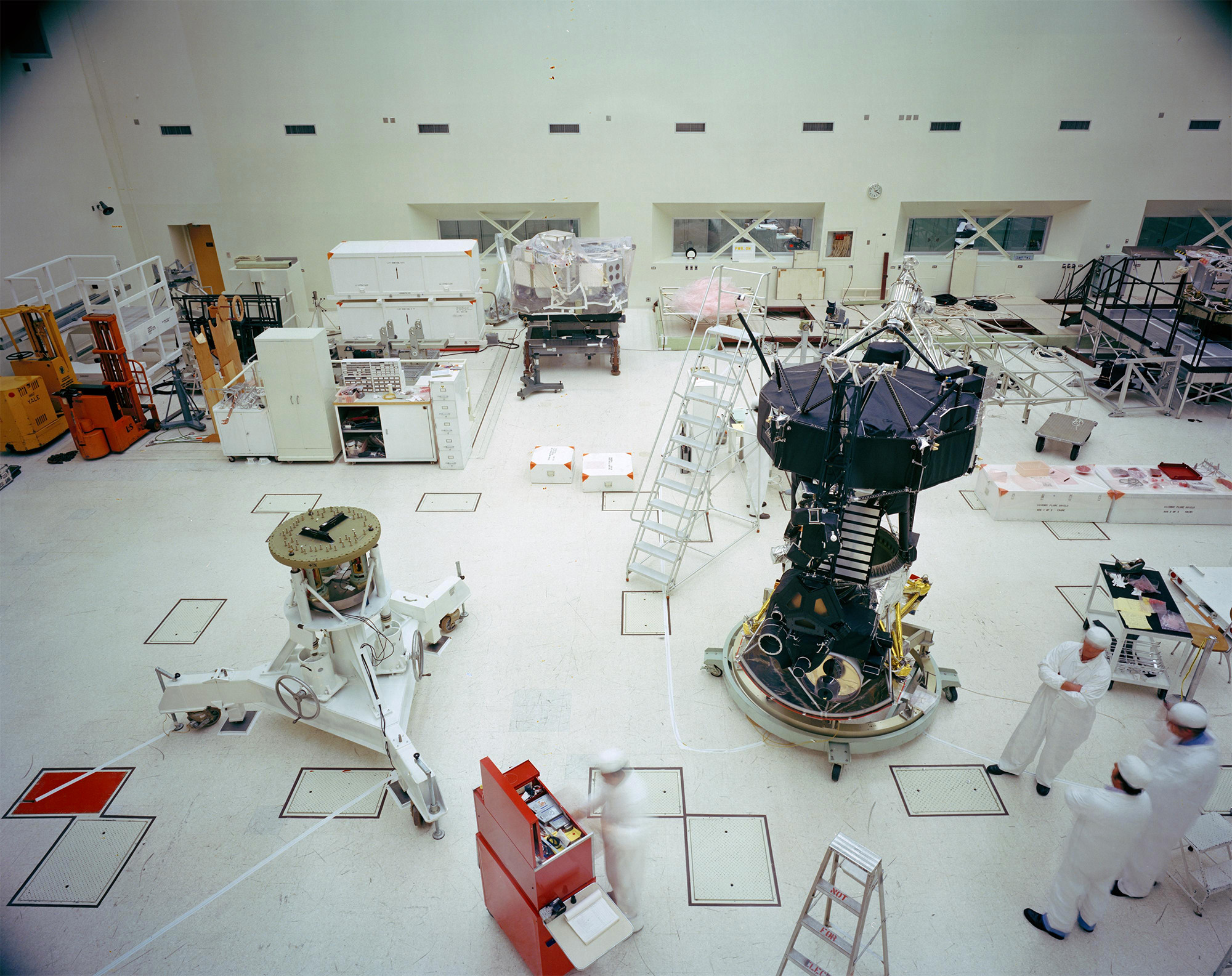
Voyager: Vibration Acoustics and Pyro Shock Testing
An engineer works on vibration acoustics and pyro shock testing for one of NASA’s Voyager spacecraft on November 18, 1976. Several of the spacecraft’s science instruments are visible at left.
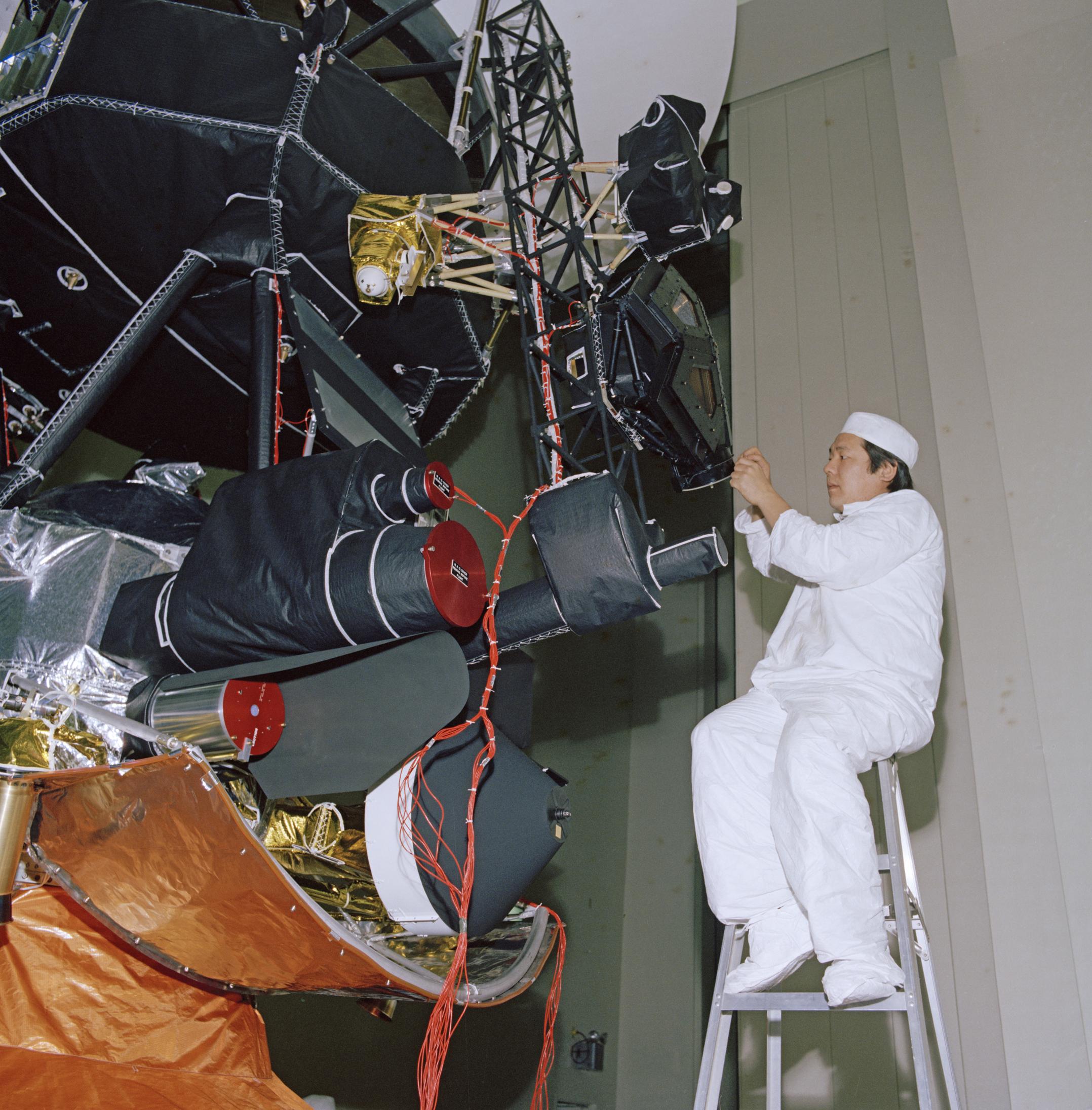
Voyager Testing: 1976
This archival photo shows engineers working on vibration acoustics and pyro shock testing of NASA’s Voyager on November 18, 1976.
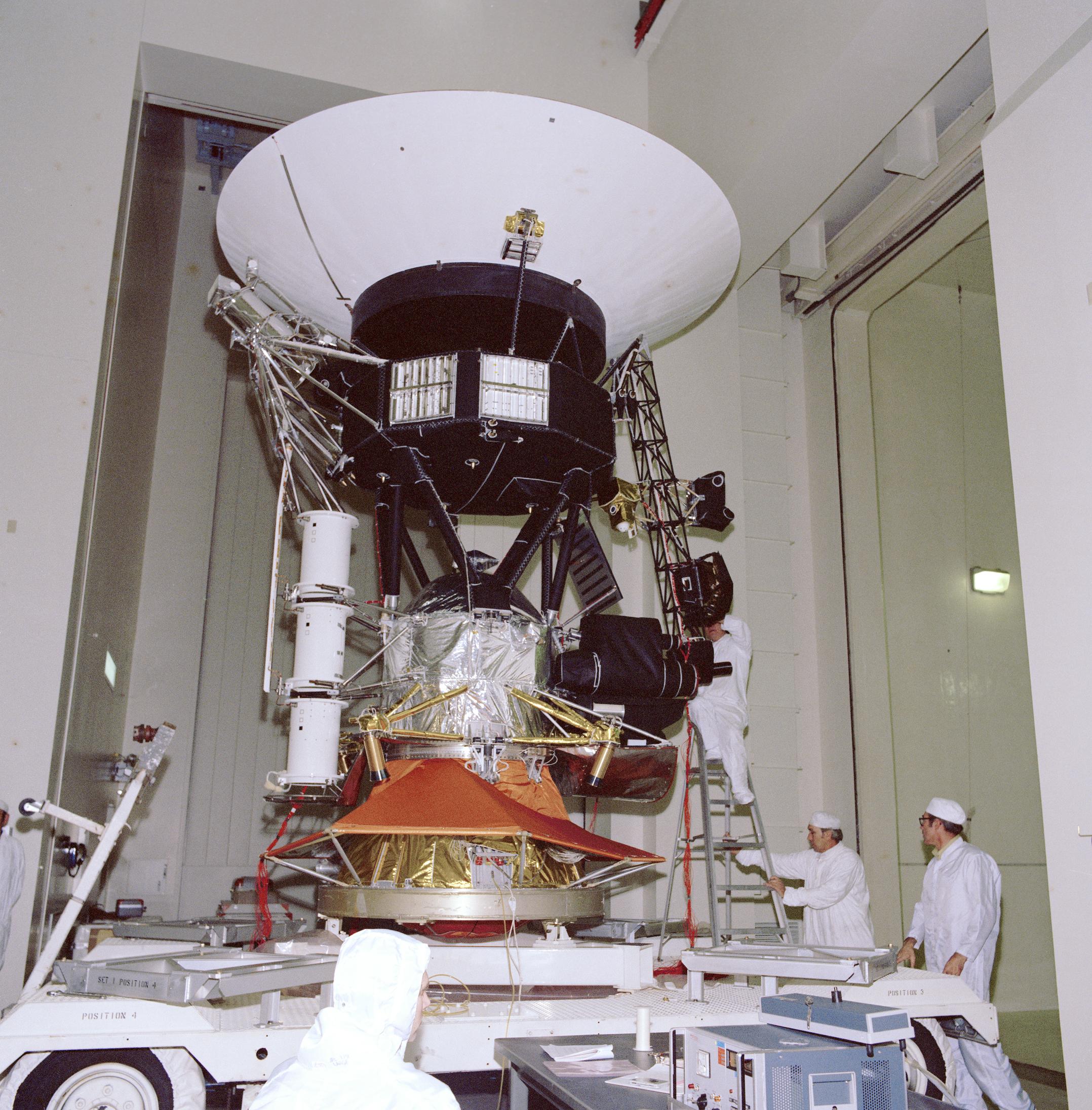
Voyager Development Test Model
This archival photo shows the encapsulation of the Voyager Development Test Model at NASA’s Kennedy Space Center’s Eastern Test Range. The picture was taken on October 8, 1976.
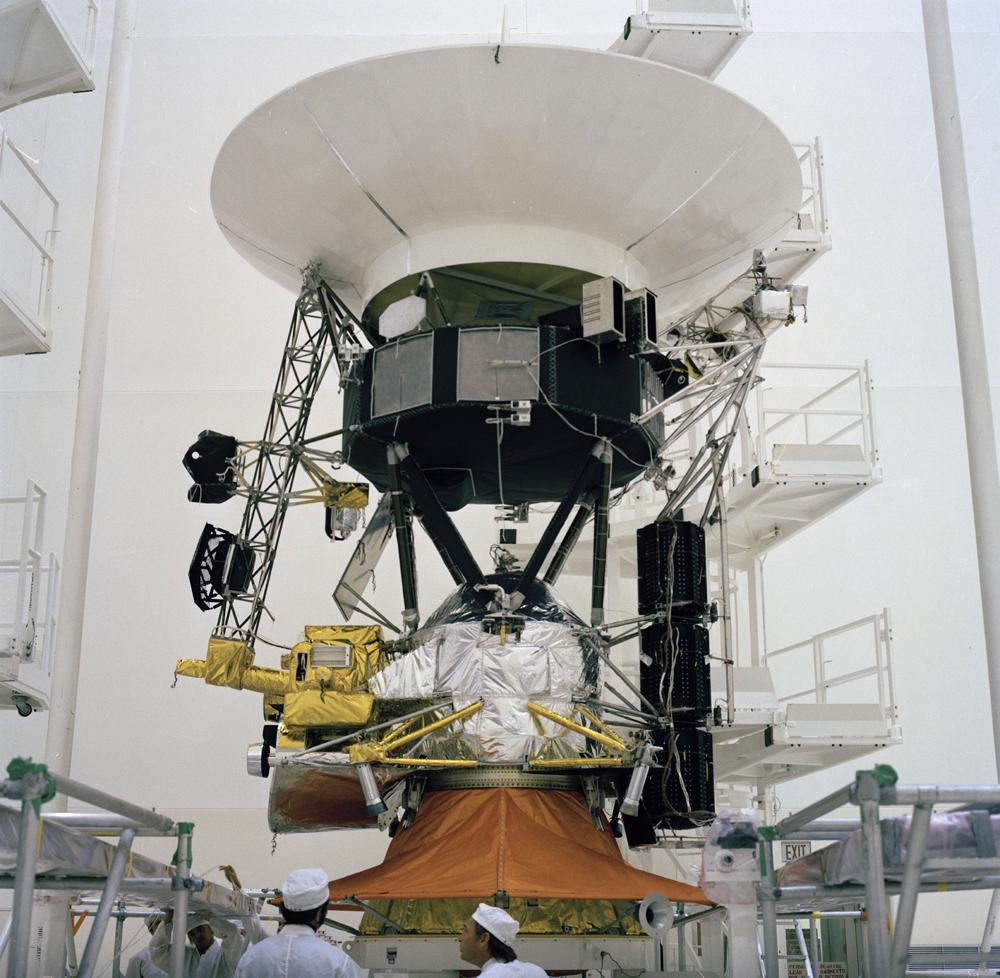
Voyager 2 Flight Hardware
This archival photo shows the Voyager proof test model, which did not fly in space, in the 25-foot space simulator chamber at NASA’s Jet Propulsion Laboratory, Pasadena, California.
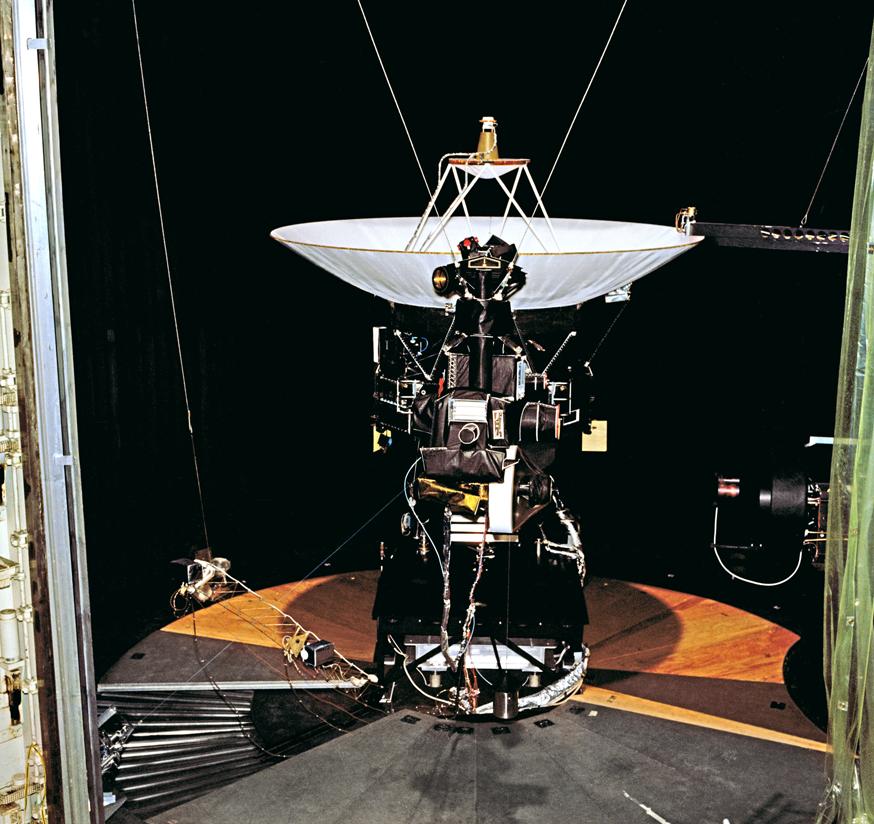
This archival photo shows engineers at NASA’s Jet Propulsion Laboratory working on the 10-sided central structure, or "bus," of the Voyager 2 spacecraft on February 24,1977.
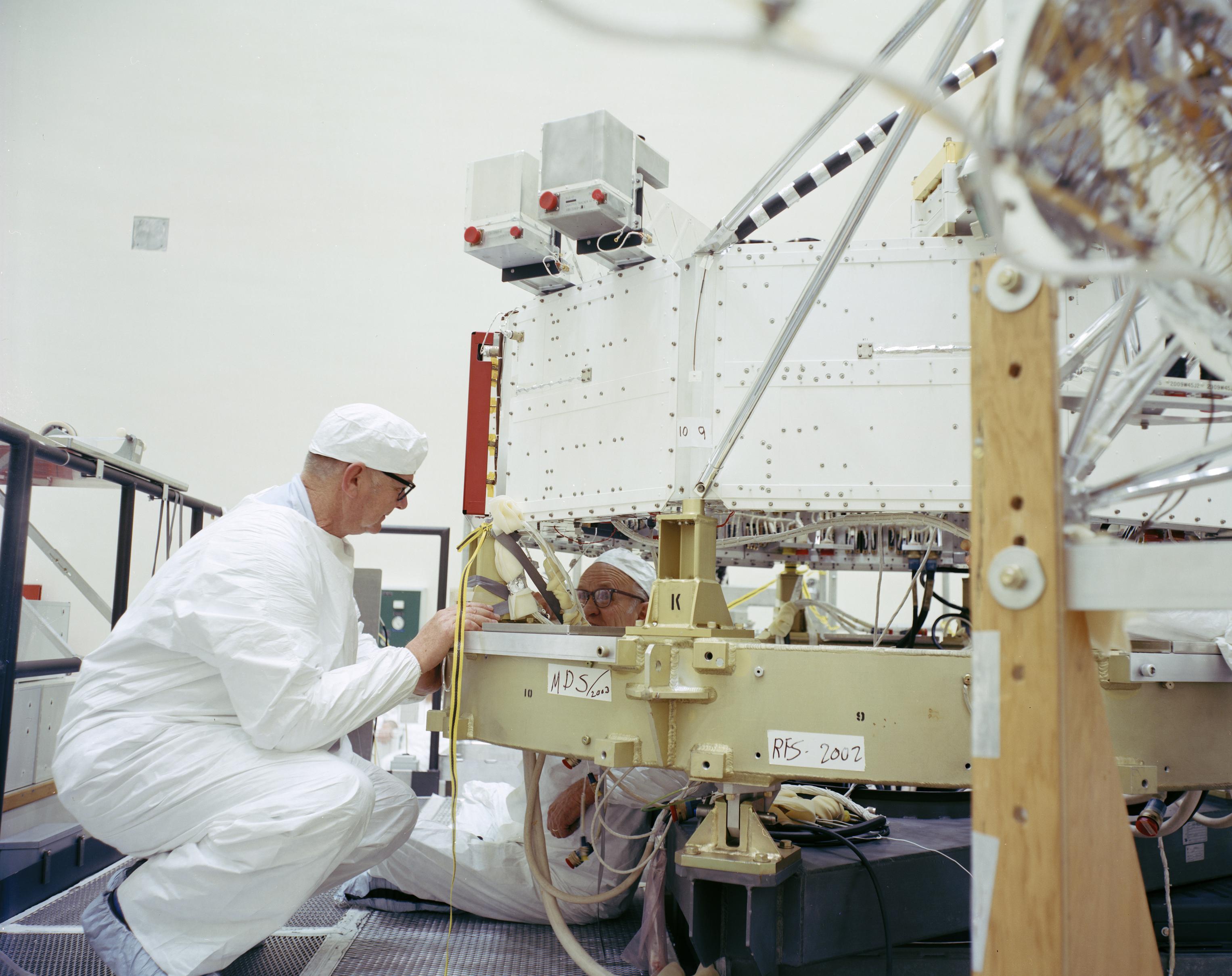
Voyager 2 Encapsulation
The Voyager 2 spacecraft, which was the first of the two Voyagers to launch, is seen at the Spacecraft Assembly and Encapsulation Facility-1 at NASA’s Kennedy Space Center in Cape Canaveral, Florida. This archival photo is from August 1977. The spacecraft was put into this shroud on August 2, 1977, to protect it during flight through the atmosphere.
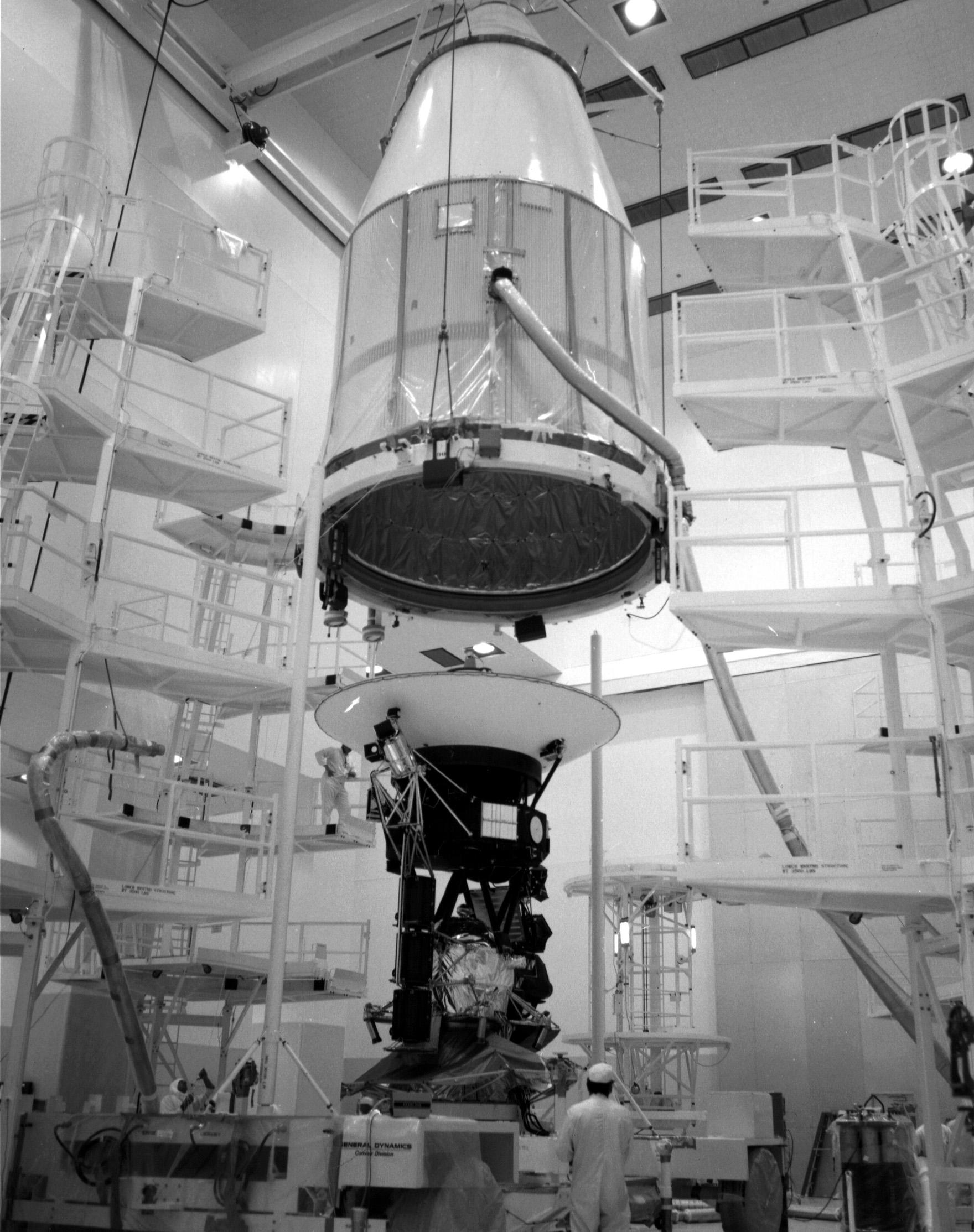
Mementos of Earth
As NASA’s two Voyager spacecraft travel out into deep space, they carry a small American flag and a Golden Record packed with pictures and sounds -- mementos of our home planet. This picture shows John Casani, Voyager project manager in 1977, holding a small Dacron flag that was folded and sewed into the thermal blankets of the Voyager spacecraft before they launched 36 years ago. Below him lie the Golden Record (left) and its cover (right). In the background stands Voyager 2 before it headed to the launch pad. The picture was taken at Cape Canaveral, Fla., on Aug. 4, 1977.
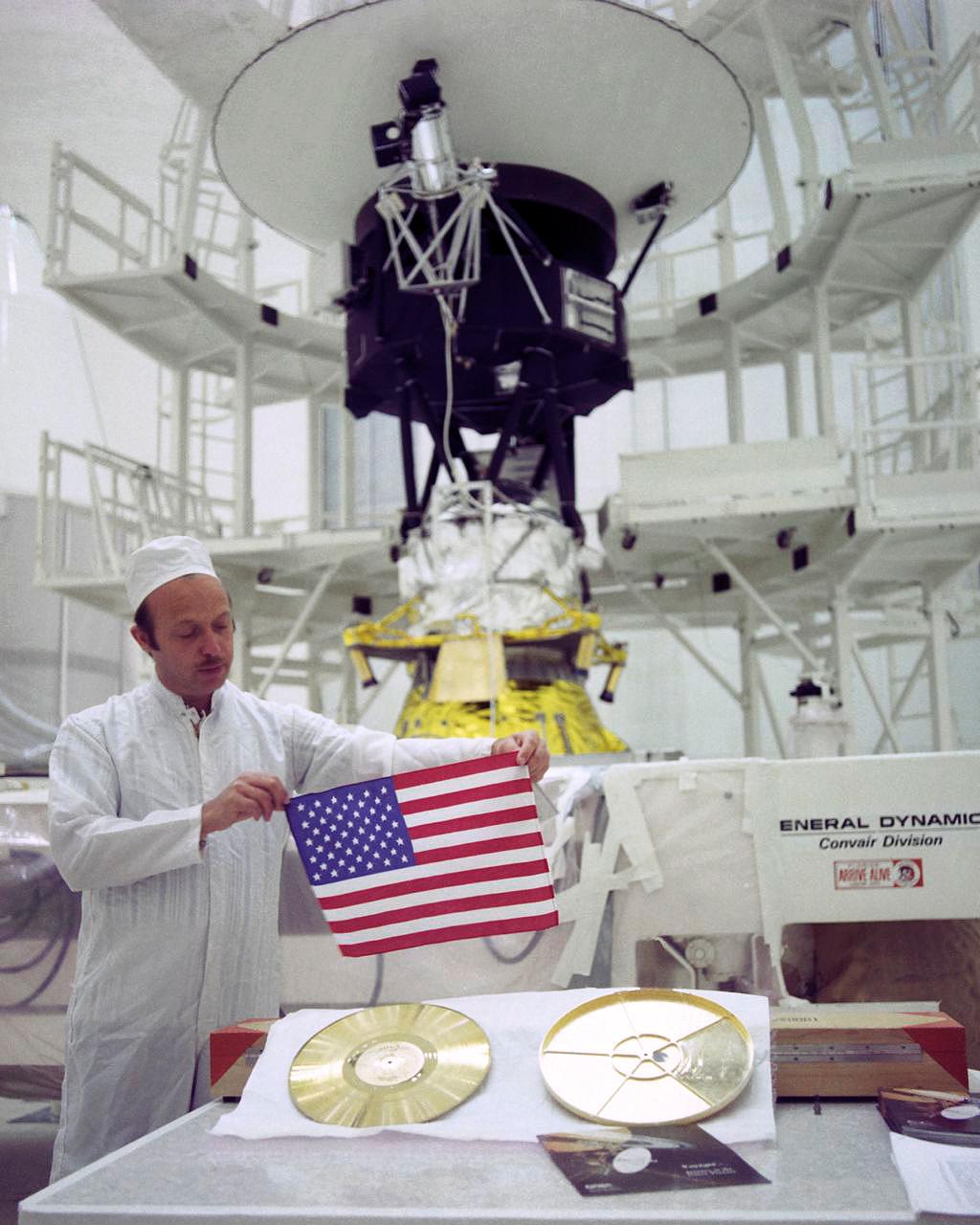
This archival photo shows Voyager 2 at the Spacecraft Assembly and Encapsulation Facility at NASA’s Kennedy Space Center in Cape Canaveral, Florida.
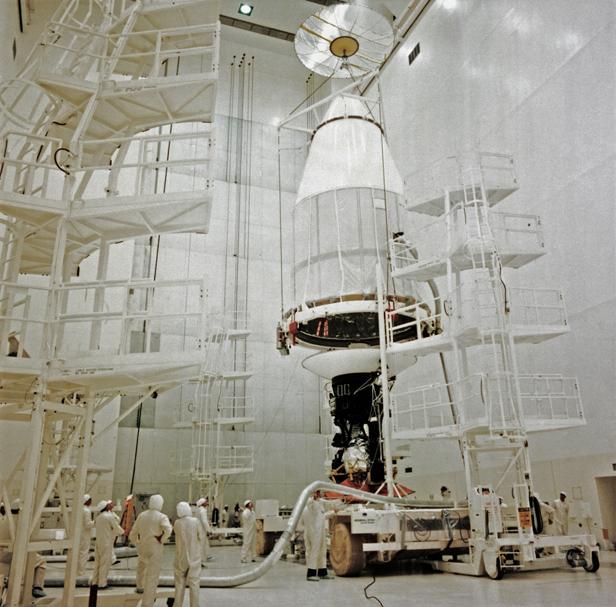
Voyager: System Test Configuration
This archival photo shows the system test configuration for Voyager on October 1, 1976. The spacecraft’s 10-sided bus is visible behind the catwalk railing in the foreground. The boom that holds several of the spacecraft’s science instruments arches above the railing.
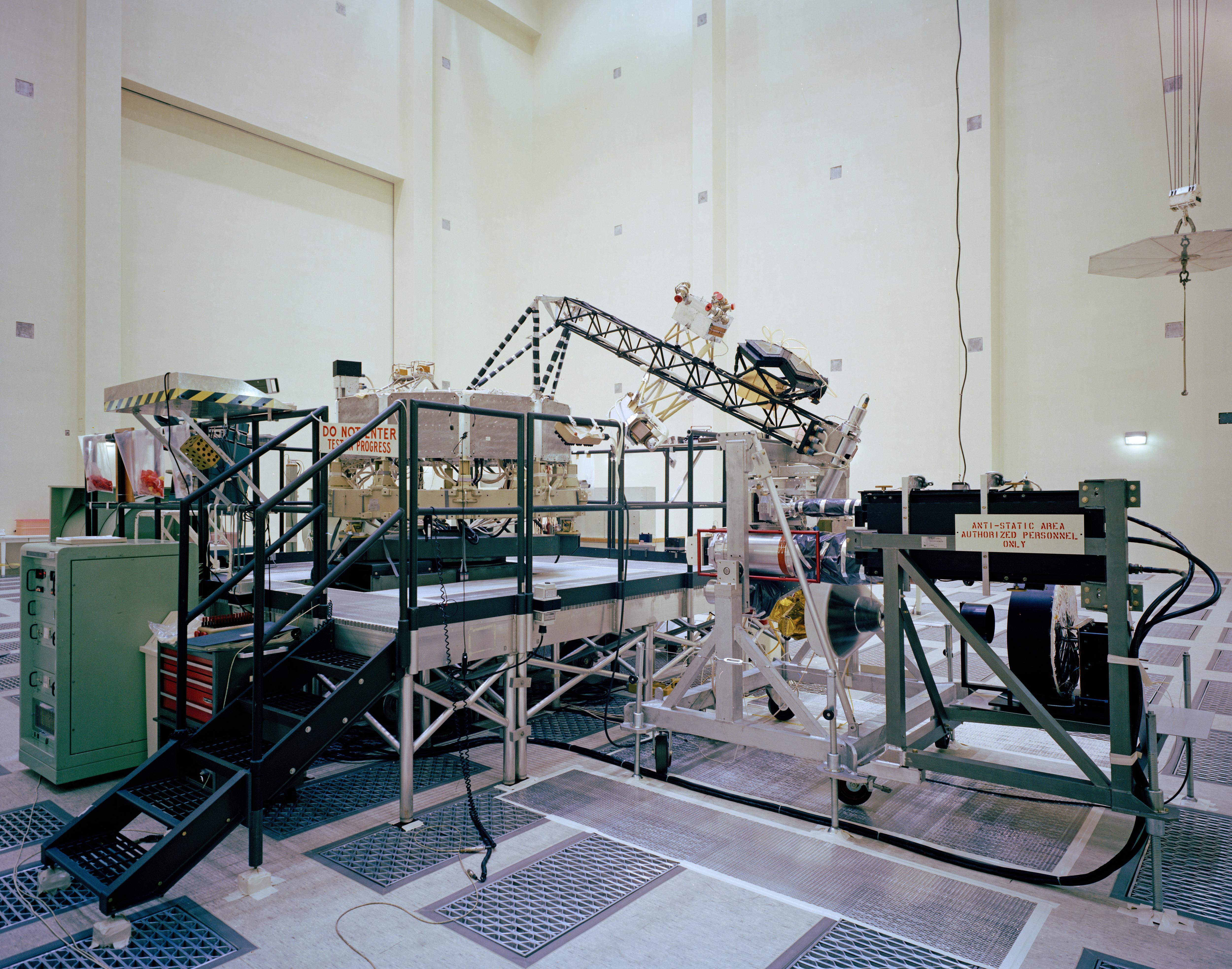
Voyager 2 in Launch Vehicle
The Voyager 2 spacecraft, encapsulated within its payload fairing, is seen in August 1977, as it was being hoisted upward for attachment to its launch vehicle at NASA’s Kennedy Space Center in Cape Canaveral, Florida.
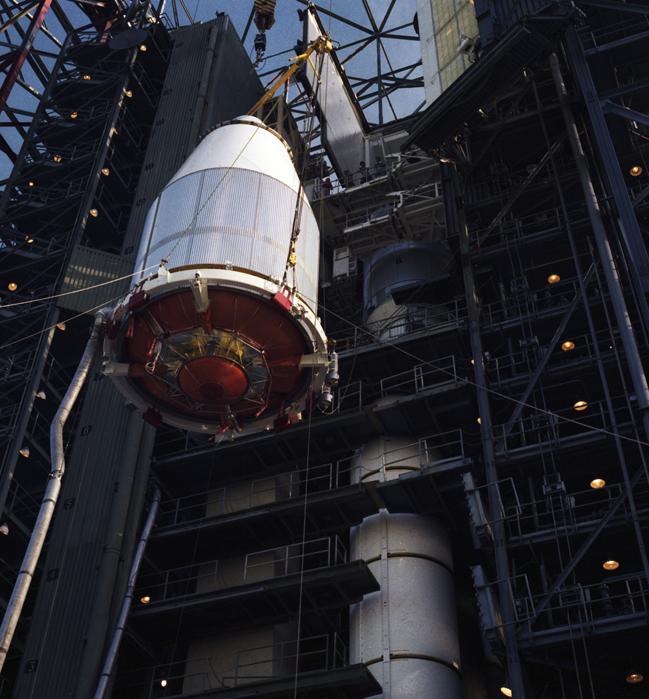
Voyager 2 Preparing for Launch
NASA’s Voyager 2 spacecraft, encapsulated within its payload fairing, is seen on August 5, 1977. It launched atop the Titan/Centaur-7 launch vehicle from Cape Canaveral Air Force Station in Florida on August 20, 1977, at 10:29 a.m. local time.
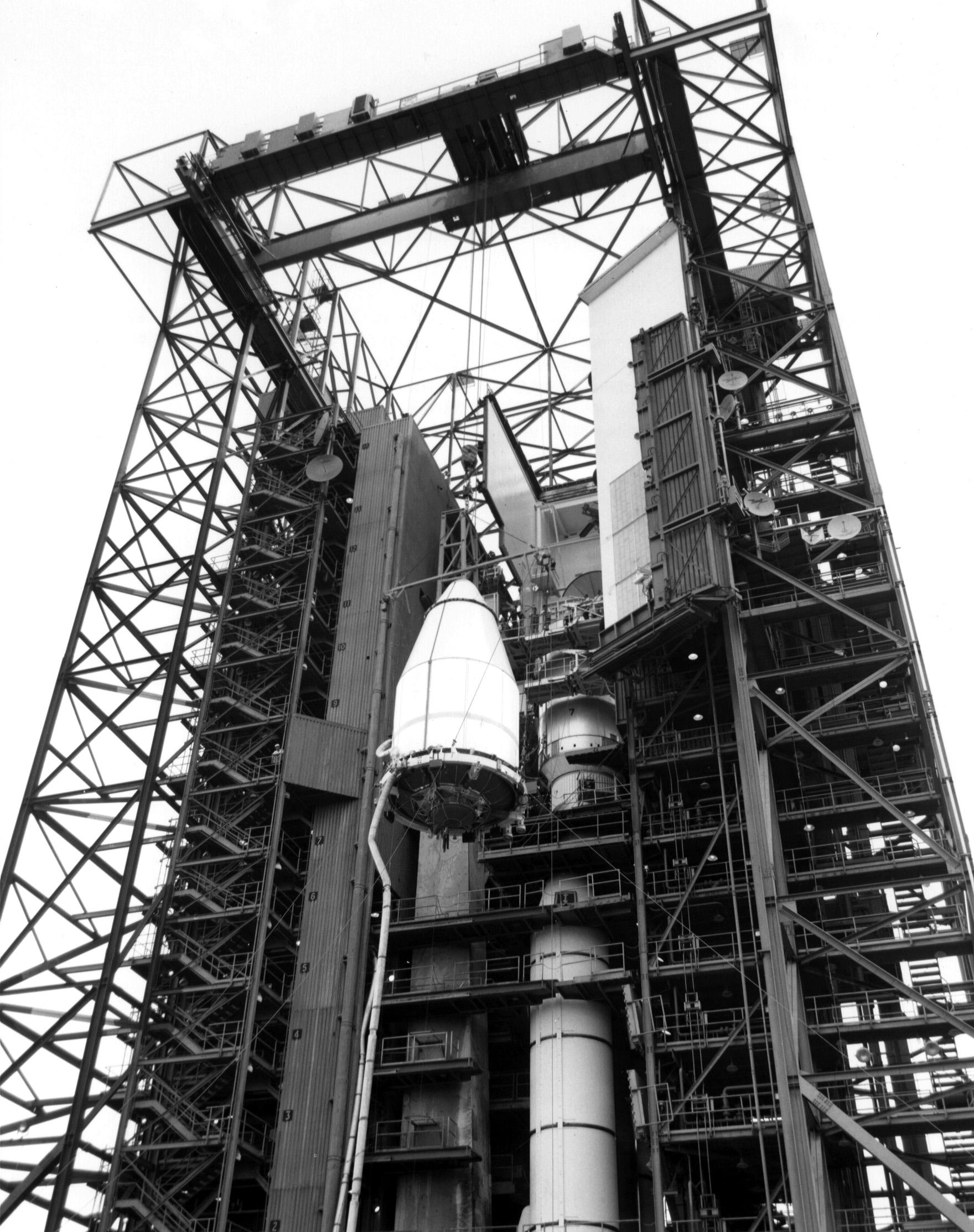
Voyager 1’s Launch Vehicle
The Titan/Centaur-6 launch vehicle was moved to Launch Complex 41 at Kennedy Space Center in Florida to complete checkout procedures in preparation for launch. The photo is dated January 1977. This launch vehicle carried Voyager 1 into space on September 5, 1977.
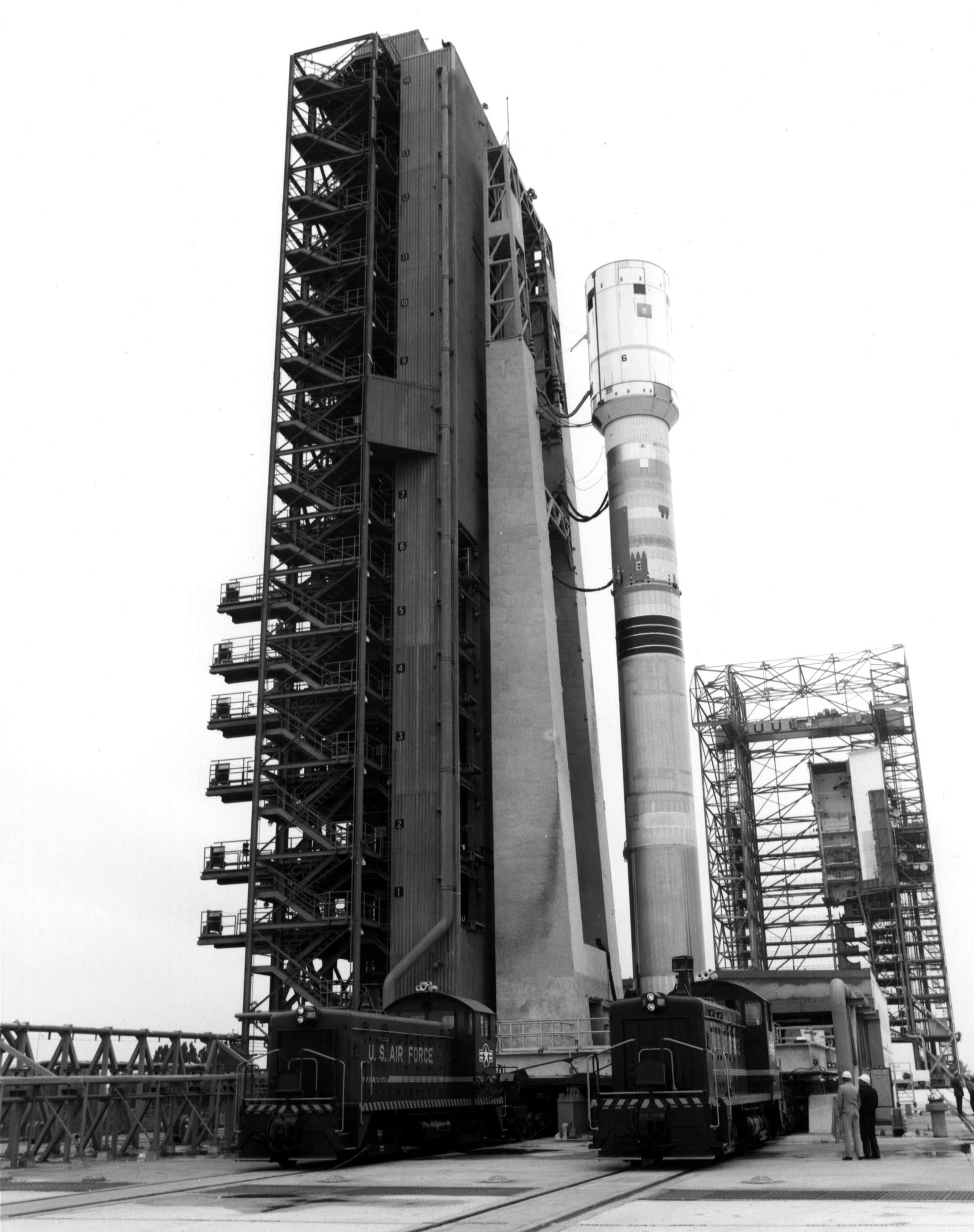

IMAGES
VIDEO
COMMENTS
Photography of Jupiter began in January 1979, when images of the brightly banded planet already exceeded the best taken from Earth. Voyager 1 completed its Jupiter encounter in early April, after taking almost 19,000 pictures and many other scientific measurements. Voyager 2 picked up the baton in late April and its encounter continued into August.
Image: NASA / JPL / Ted Stryk. Saturn as seen by Voyager 1 The last picture from Voyager 1's approach to Saturn in which the entire planet and ring system can be seen in a single frame. Image: NASA/JPL/Björn Jónsson. Voyager 2's best view of Enceladus This was the Voyager mission's best view of Enceladus, captured by Voyager 2 on August 26 ...
Voyager was the first spacecraft to achieve this and captured the iconic image on Sept. 18, 1977, by Voyager 1 when it was 7.25 million miles from Earth. The moon is at the top of the picture and ...
Early Voyager 1 Images of Jupiter Full Resolution: TIFF (491.5 kB) JPEG (21.78 kB) 1996-09-26: Jupiter: Voyager: Imaging Science Subsystem: 400x400x3: PIA00029: First Close-up Image of Jupiter from Voyager ...
On Feb. 14, 1990, NASA's Voyager 1 probe snapped a photo of Earth from 3.7 billion miles (6 billion kilometers) away. ... In Indiana, the best spot to see the 2024 solar eclipse is wherever you are.
Each Voyager space probe carries a gold-plated audio-visual disc in the event that the spacecraft is ever found by intelligent life forms from other planetary systems. Examine the images and sounds of planet earth. Images Voyager Took The Voyager 1 and 2 spacecraft explored Jupiter, Saturn, Uranus and Neptune before starting their journey ...
Here are 18 groundbreaking photos from their incredible mission. This montage shows examples of striking images of the solar system Voyager 1 and 2 took on their missions. NASA/JPL/Insider. Nearly ...
This photo of Jupiter was taken by NASA's Voyager 1 on the evening of March 1, 1979, from a distance of 2.7 million miles (4.3 million kilometers). ... This updated version of the iconic "Pale Blue Dot" image taken by the Voyager 1 spacecraft uses modern image-processing software and techniques to revisit the well-known Voyager view while ...
Early Voyager 1 Images of Jupiter Full Resolution: TIFF (491.5 kB) JPEG (21.78 kB) 1996-09-26: Jupiter: Voyager: Imaging Science Subsystem: 400x400x3: PIA00029: First Close-up Image of Jupiter from Voyager ...
Our crescent Earth and moon in the first picture of its kind ever captured by a spacecraft. Taken on Sept. 18, 1977, 7 million miles (12 million km) away from Earth. Voyager 1's closest approach ...
On March 5, 1979, NASA's Voyager 1 flew by Jupiter, the largest planet in the solar system, in a historic encounter with the largest planet in our solar system. See the amazing photos here.
Now 40 years old and in interstellar space, NASA's Voyager 1 spacecraft has already been immortalised in these incredible photos. On 5 September 1977 - two weeks after Voyager 2 - Voyager 1 ...
In 1998, Voyager 1 became the farthest human-made object in space — 6.5 billion miles from Earth. The probes are now 12 billion and 14.5 billion miles away from Earth and counting, according to ...
At ~6 km/pixel, this is the highest resolution pre-Juno color data for Jupiter (all of the higher resolution Voyager images are clear filter images). Lower resolution orange, green and violet images from Voyager 1's wide angle camera (WAC) are also used to show the GRS periphery and surrounding areas. Color, contrast, and sharpness have been ...
Voyager 1 Perspective for Family Portrait Full Resolution: TIFF (2.496 MB) JPEG (336.9 kB) 2021-05-11: Voyager: 1241x427x3: PIA24572: Weak and Strong Plasma Oscillation Signals Full Resolution: TIFF (960.8 kB) JPEG (80.75 kB) 2021-11-30: Europa: Galileo Voyager: 1100x600x3: PIA24895: Three Views of Europa Full Resolution: ...
The Pale Blue Dot - Revisited. The Pale Blue Dot is a photograph of Earth taken Feb. 14, 1990, by NASA's Voyager 1 at a distance of 3.7 billion miles (6 billion kilometers) from the Sun. The image inspired the title of scientist Carl Sagan's book, "Pale Blue Dot: A Vision of the Human Future in Space," in which he wrote: "Look again at that ...
Today, Voyager 1 is the most distant spacecraft from Earth, more than 14 billion miles away and continuing on its journey out of our solar system. Forty years ago, it made its closest approach to Saturn. Although it was not the first to explore the giant ringed planet, as the Pioneer 11 spacecraft completed the first flyby in 1979, Voyager ...
This narrow-angle color image of the Earth, dubbed "Pale Blue Dot," is a part of the first ever "portrait" of the solar system taken by Voyager 1. › Full image and caption. These six narrow-angle color images were made from the first ever "portrait" of the solar system taken by Voyager 1, which was more than 4 billion miles from Earth and ...
The New Horizons photo of Voyager 1 (yellow circle), set against a backdrop of stars and galaxies. NASA/Johns Hopkins APL/Southwest Research Institute. In this photo, the two spacecraft are ...
Voyager 1, traveling outbound some 15 billion miles (24 billion km) from Earth, started beaming unreadable data down to ground controllers on November 14. For nearly four months, NASA knew Voyager ...
Launched in 1977, NASA's Voyager 1 became the first spacecraft to travel beyond our solar system into interstellar space in 2012.
On April 8, 2024, a total solar eclipse drew its enormous shadow over North America, cutting a 115-mile-wide (185 kilometers), 10,000-mile-long (16,000 km) path of sudden darkness across the ...
S tar Trek: Voyager is a great show, spoiler alert on that one. We've given plenty of love to Voyager over the years and for a lot of reasons. Kathryne Janeway is one of the best-written captains ...
Fast-forward to the third season finale of Star Trek: Voyager, and the Borg (who originated in the Delta Quadrant) made a splashy appearance that ultimately gave us the fan-favorite character ...
After 11 years of interstellar exploration, in Nov. 2023, Voyager 1's binary code — the computer language it uses to communicate with Earth — stopped making sense. Its 0's and 1's didn't mean ...
The 2024 total solar eclipse passed over Earth Monday and the country was enthralled. The eclipse covered hundreds of cities and towns in a 115-mile wide path of totality across 13 U.S. states ...
Images of Voyager. Get an in-depth look at the science instruments aboard the Voyager spacecraft, plus diagrams illustrating the spacecraft's trajectory, orbit and mechanics. Here you'll also find a number of artist's concepts explaining the anatomy of our solar system and the Voyagers' journey to reach interstellar space.